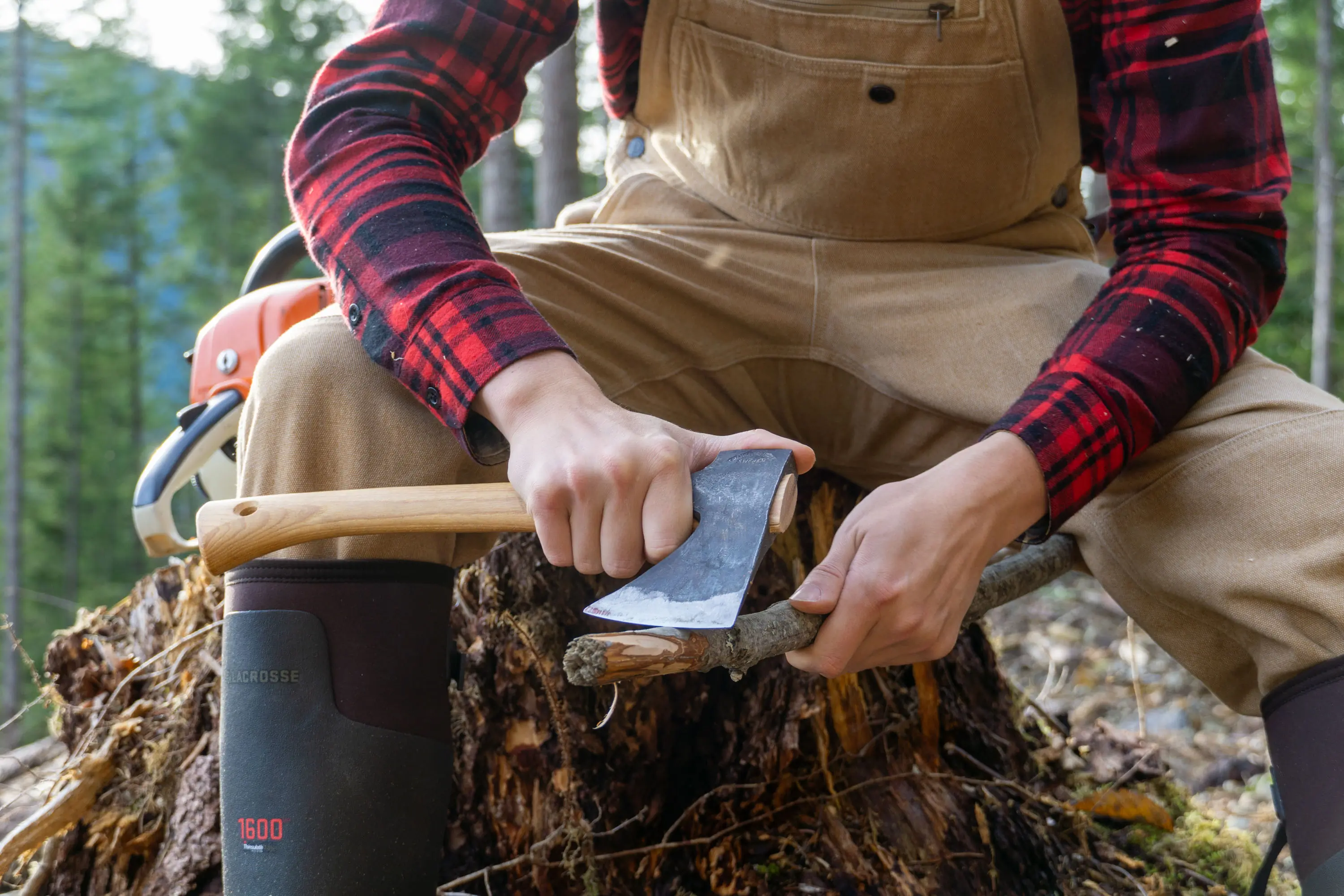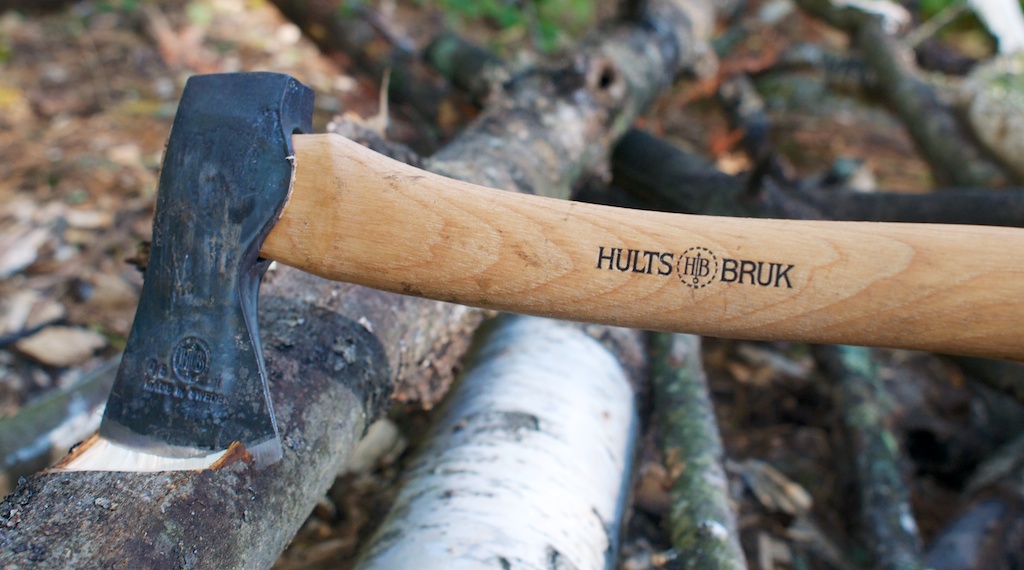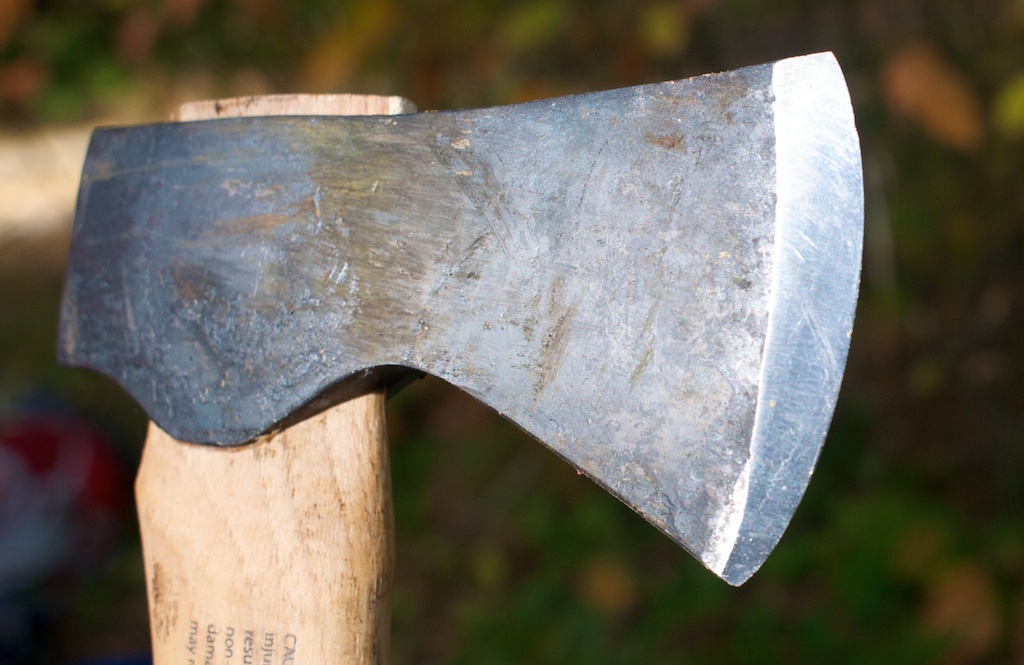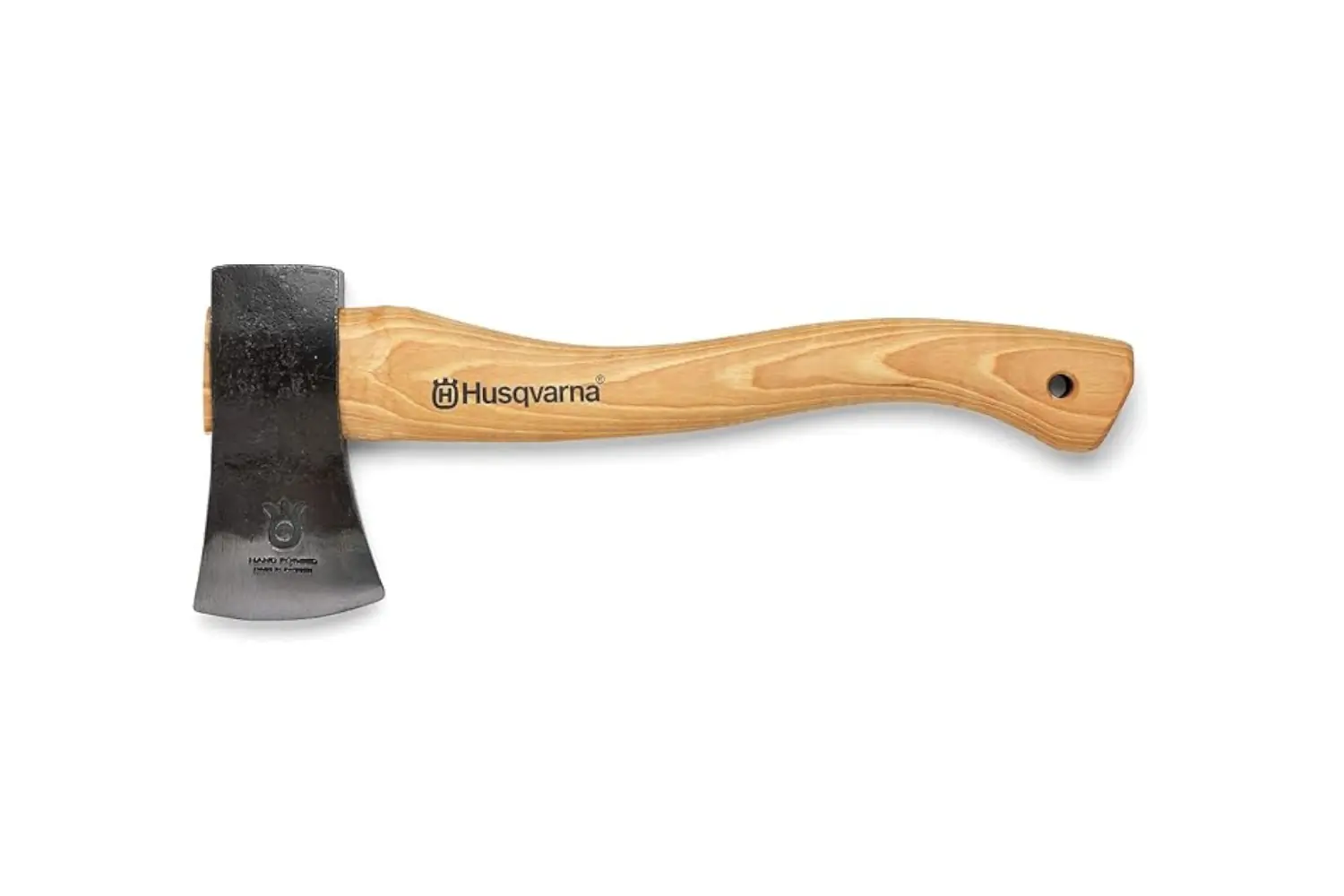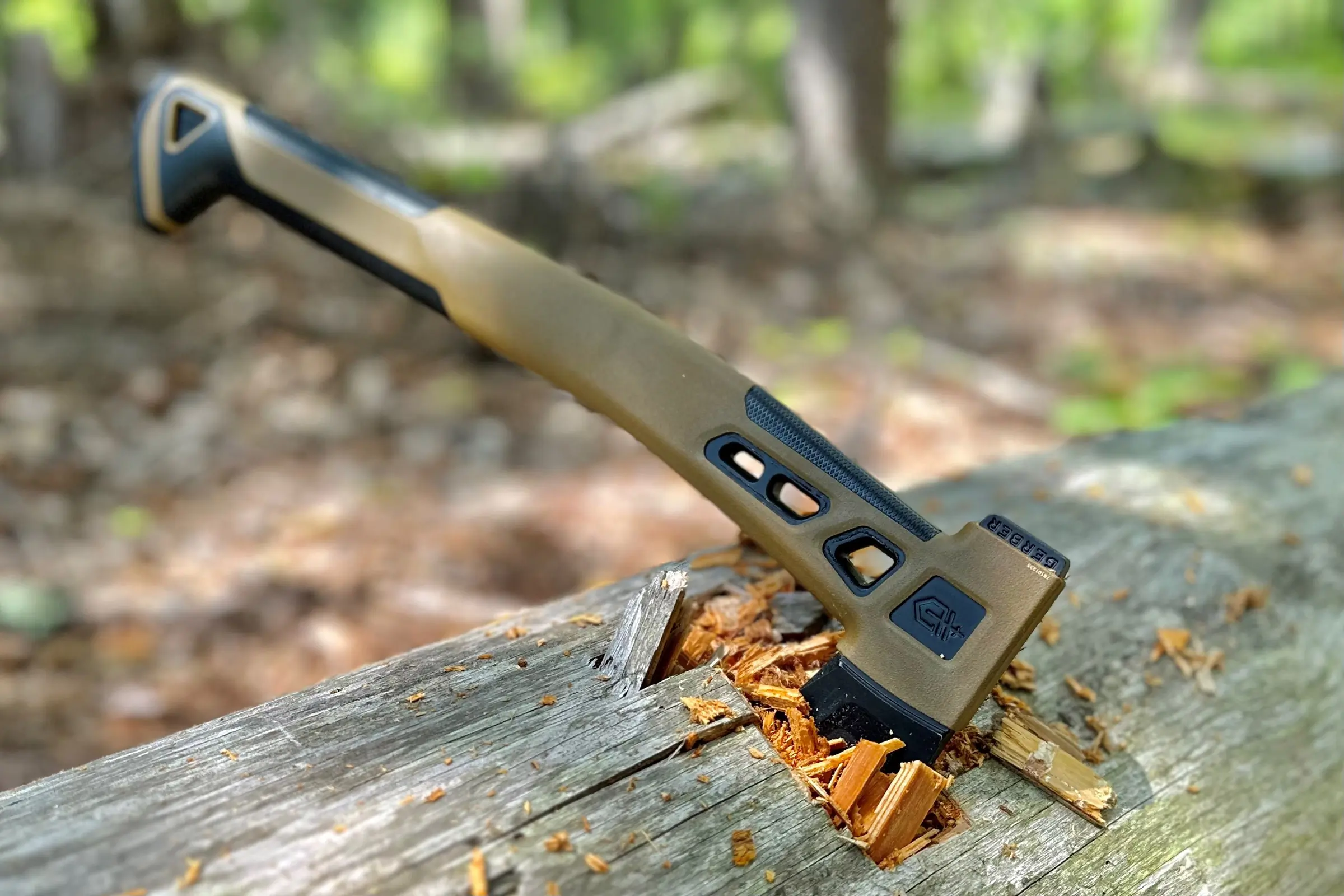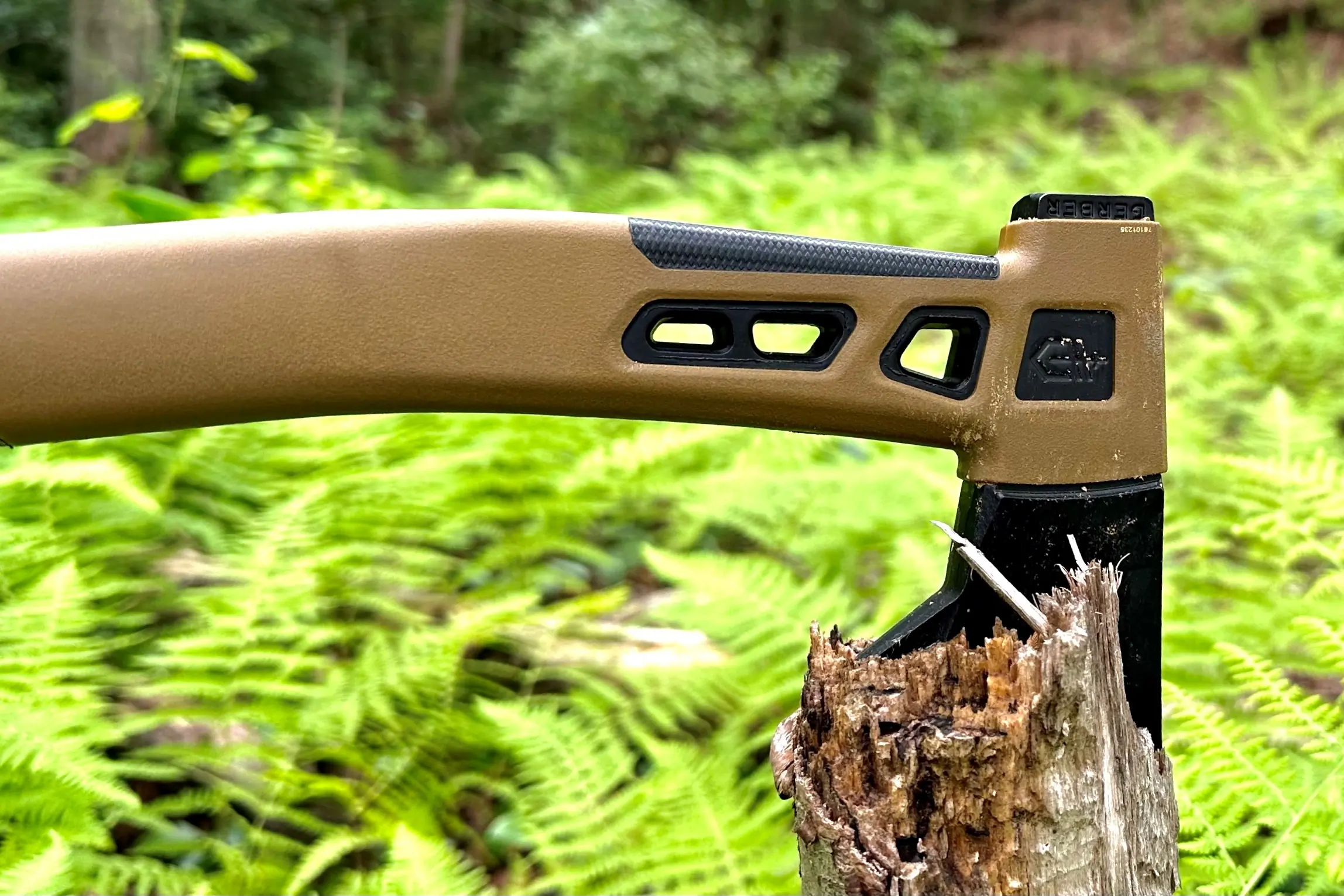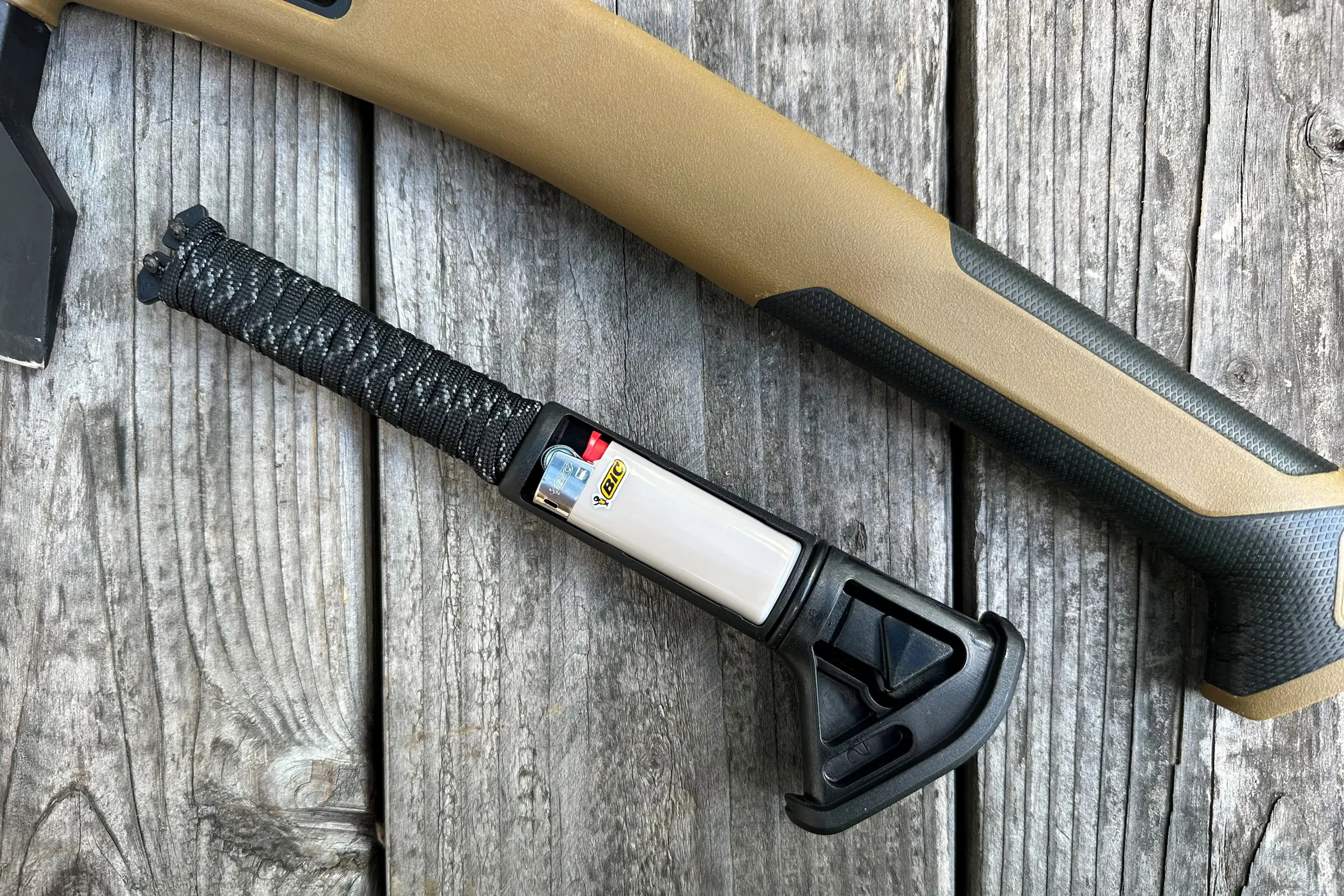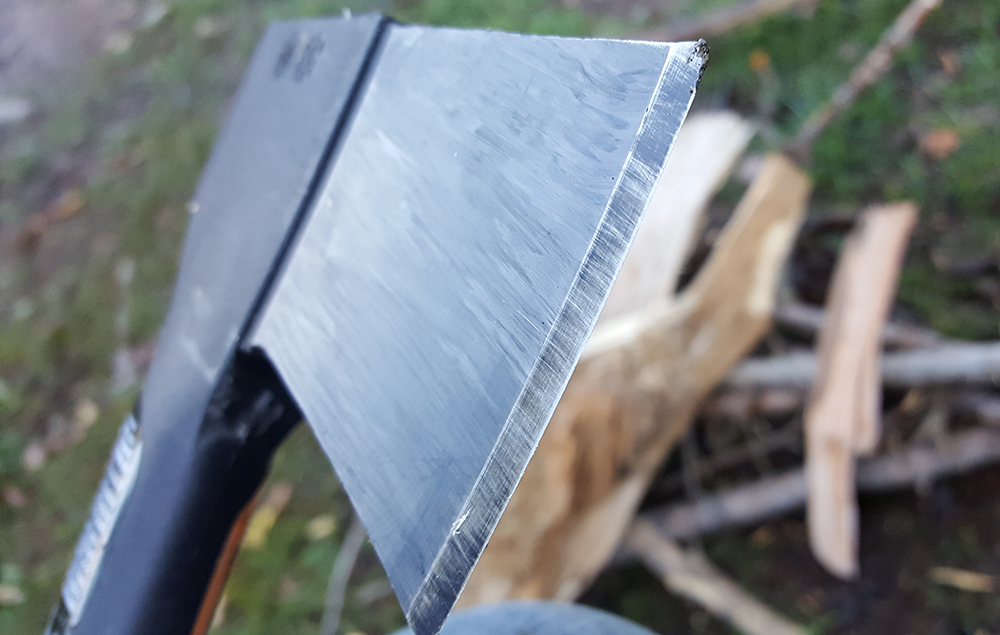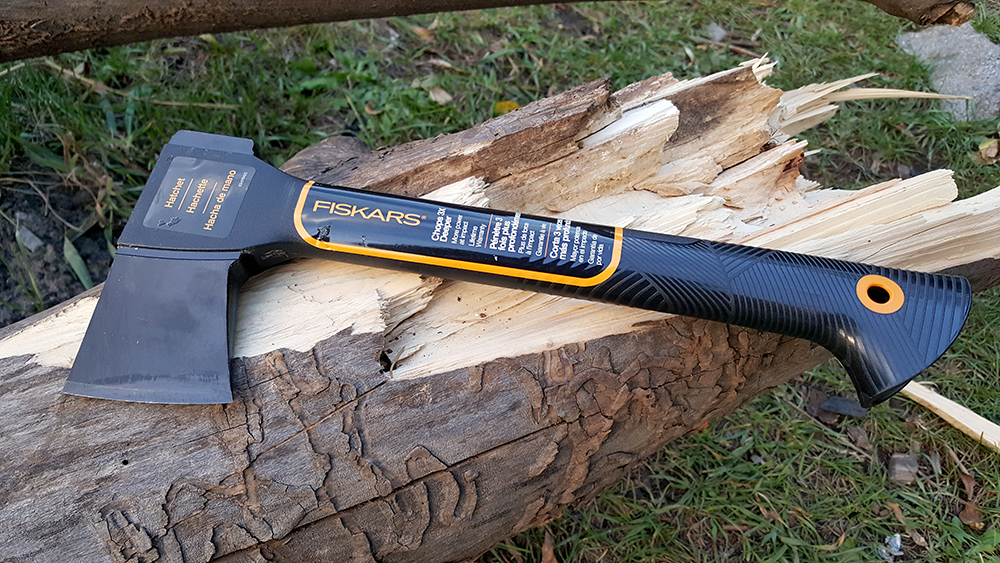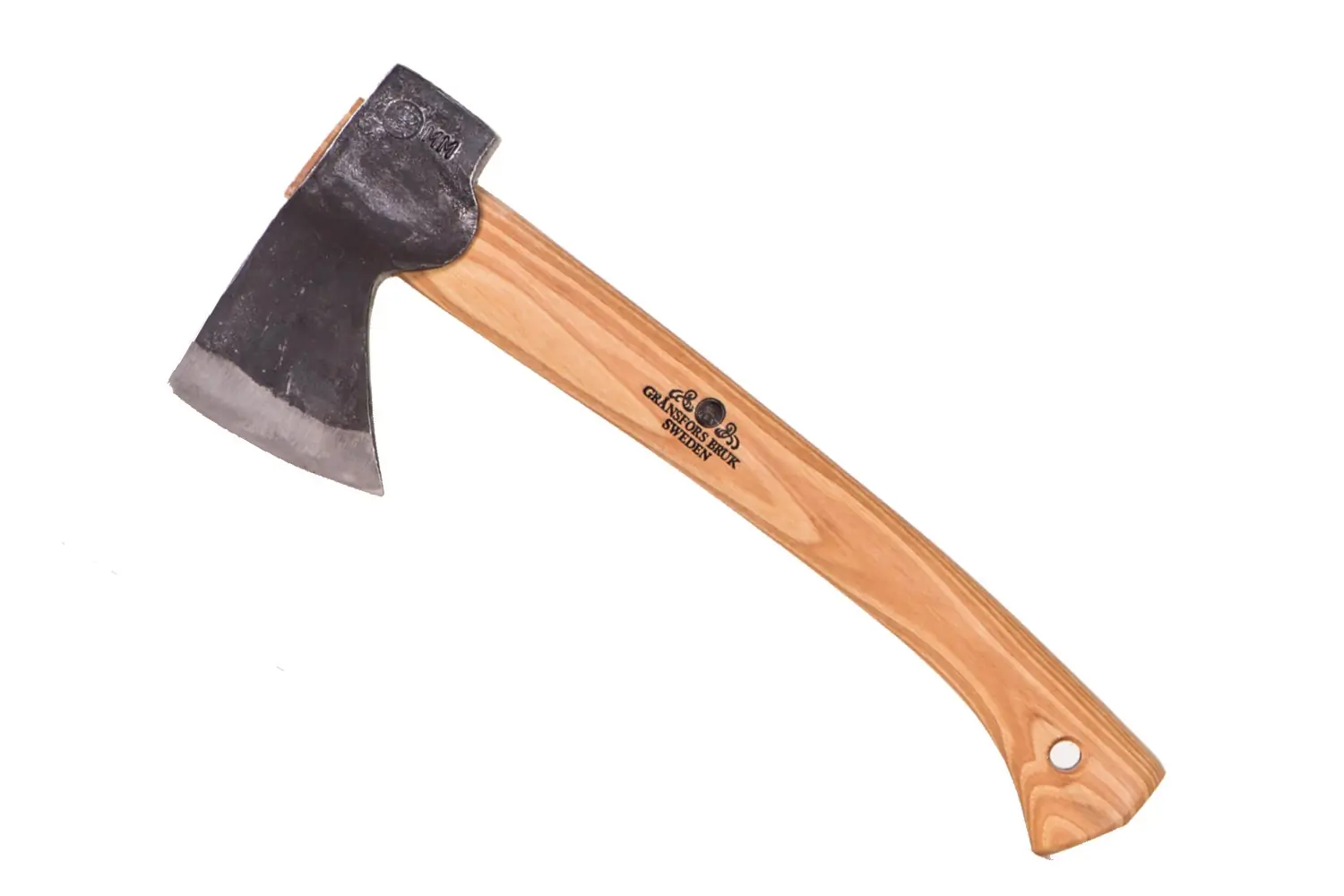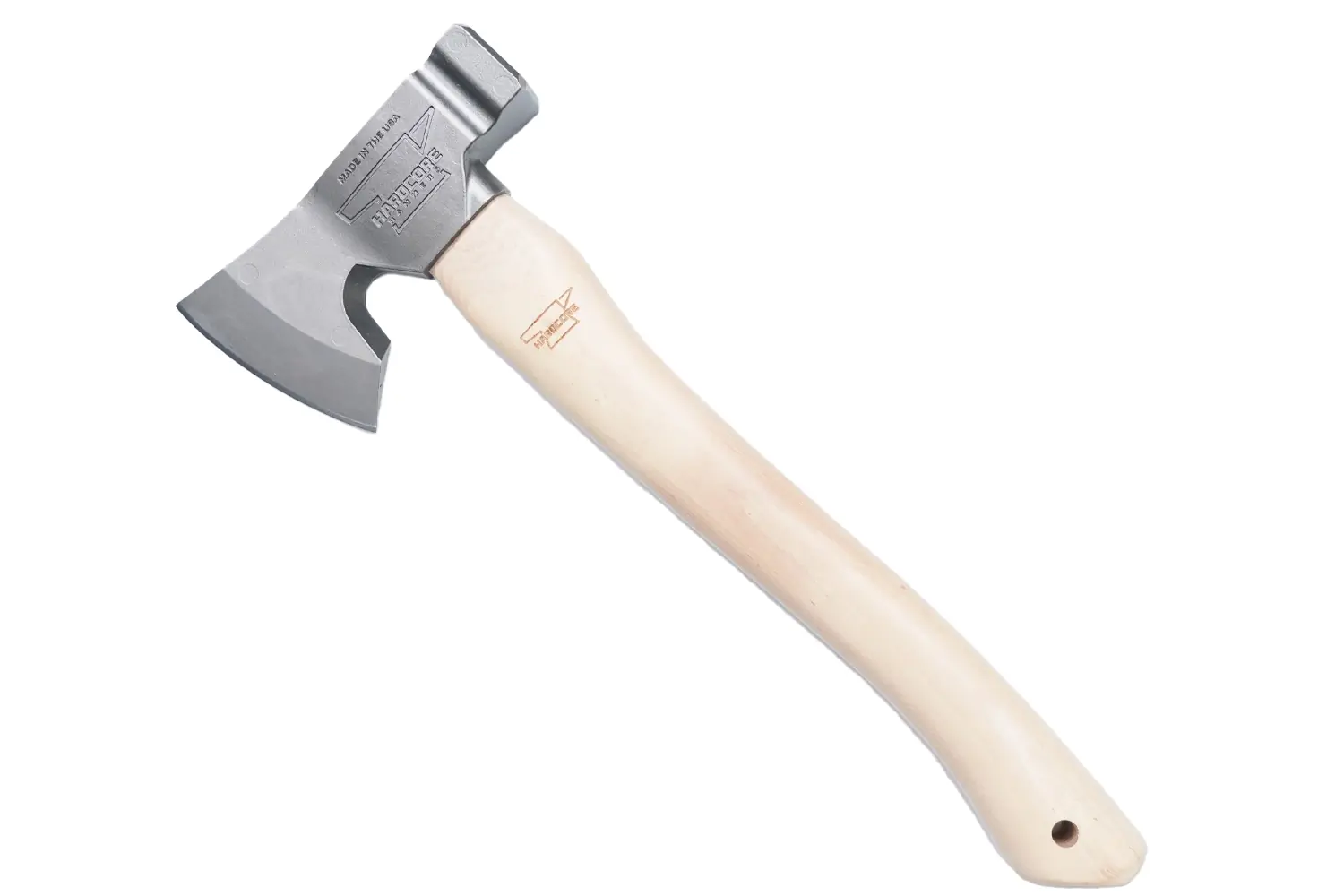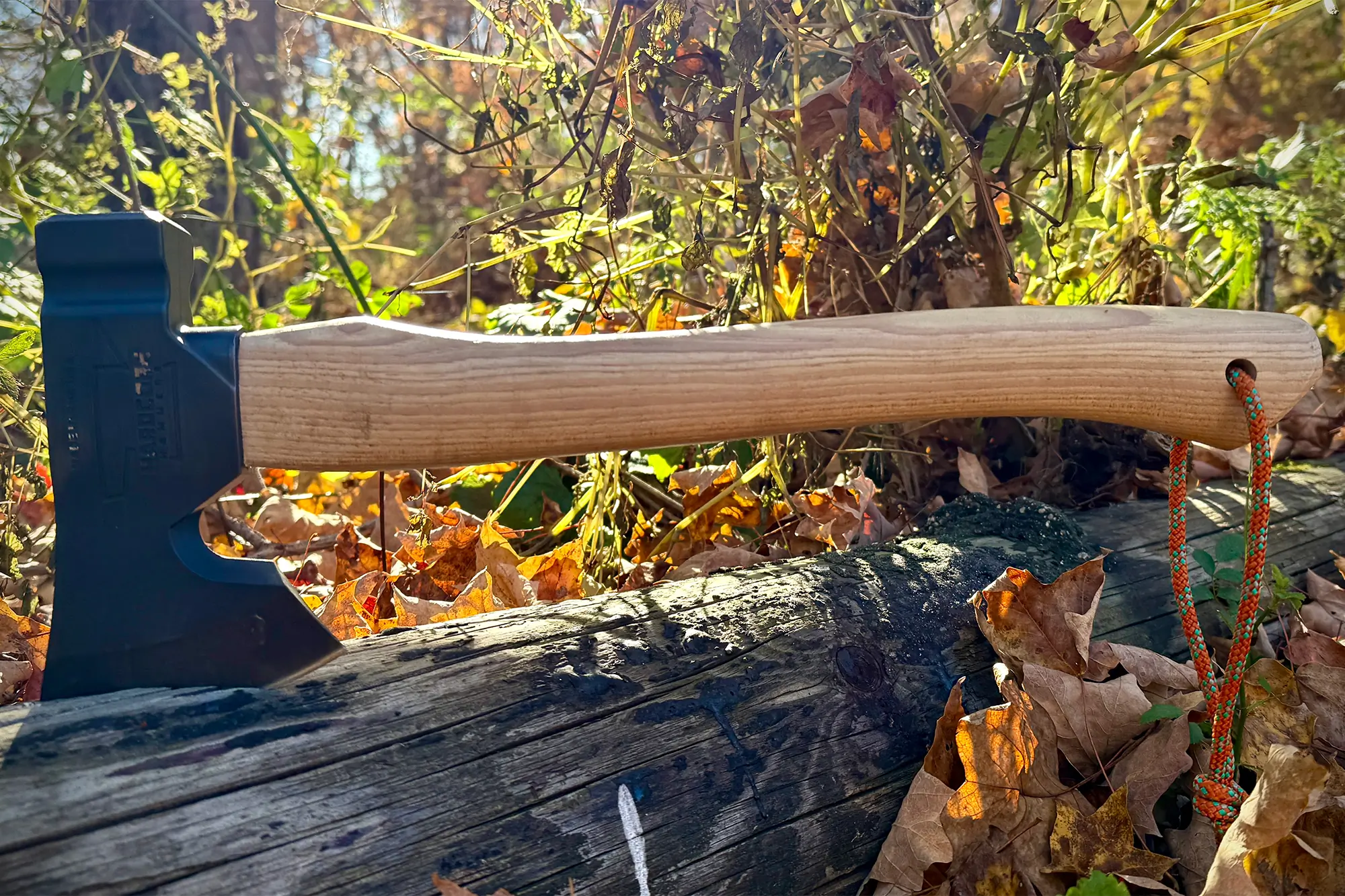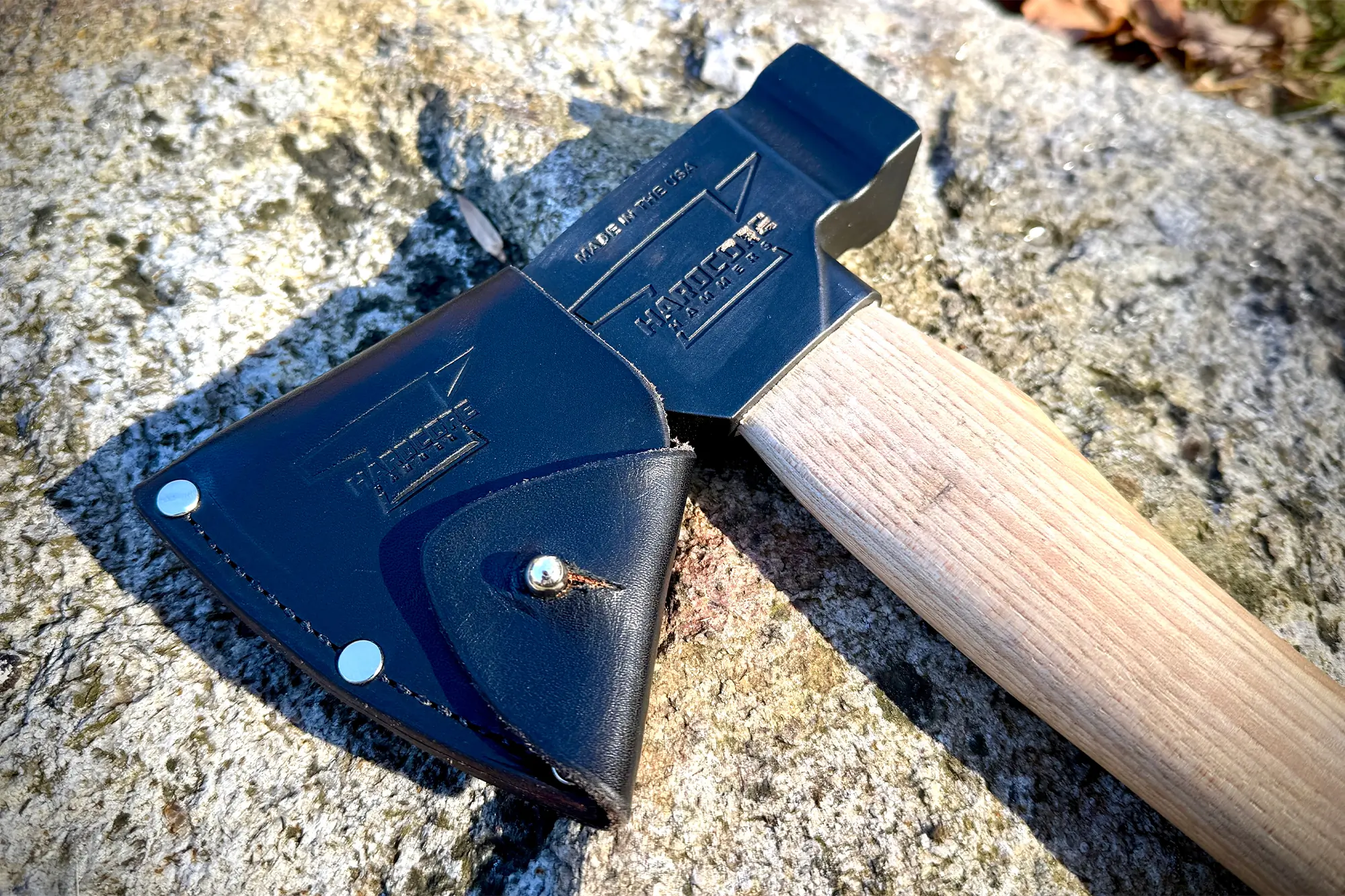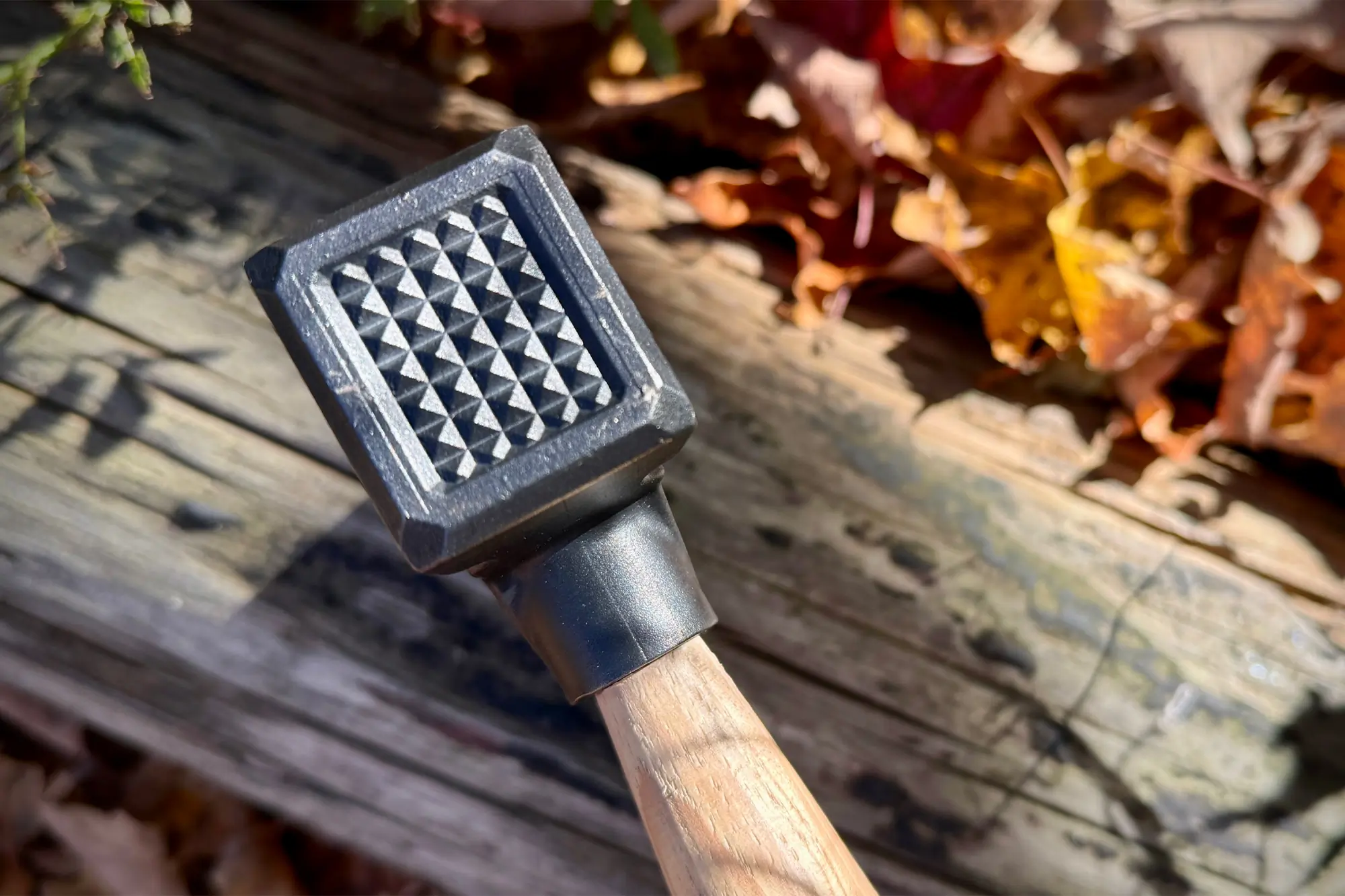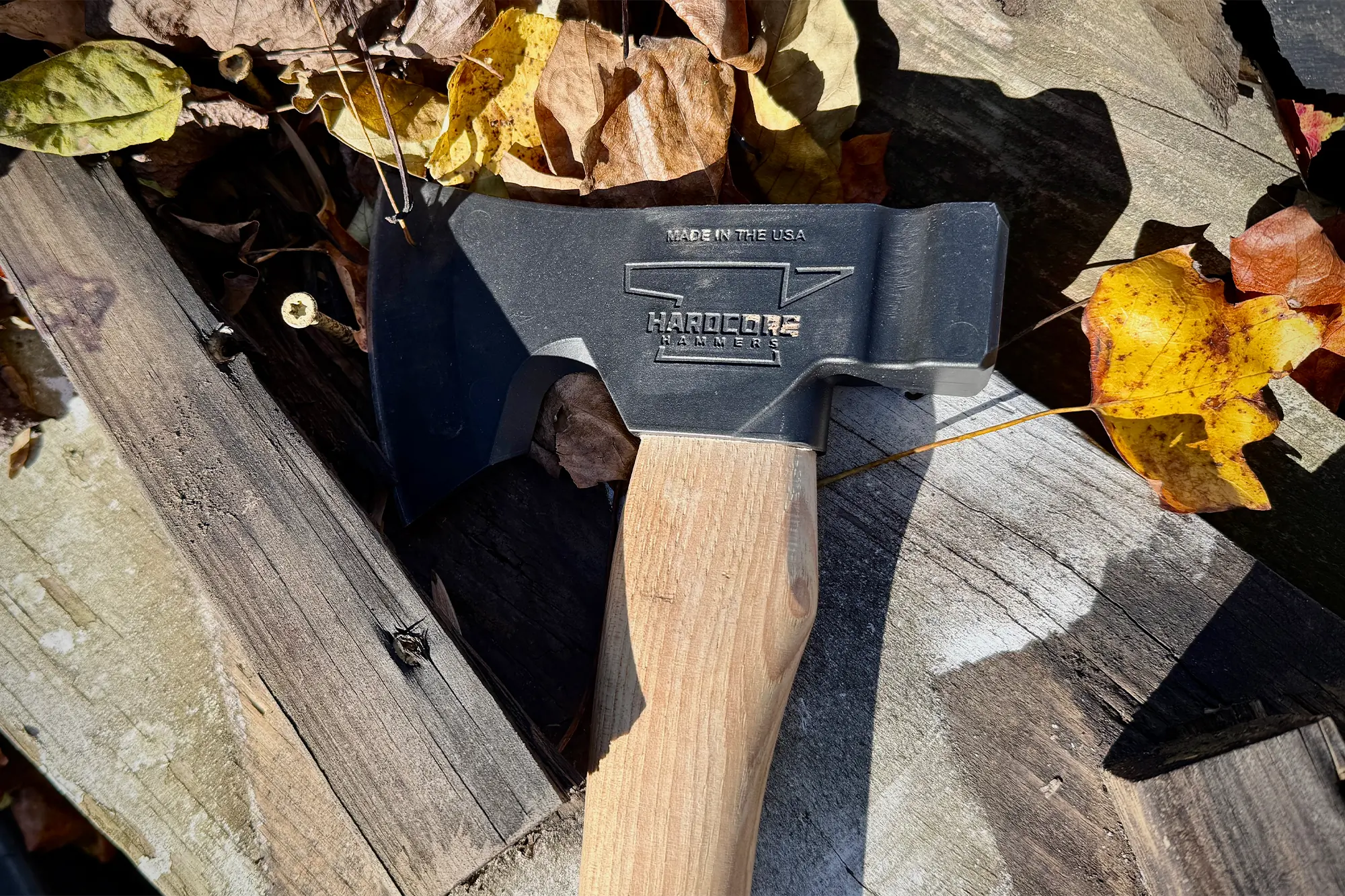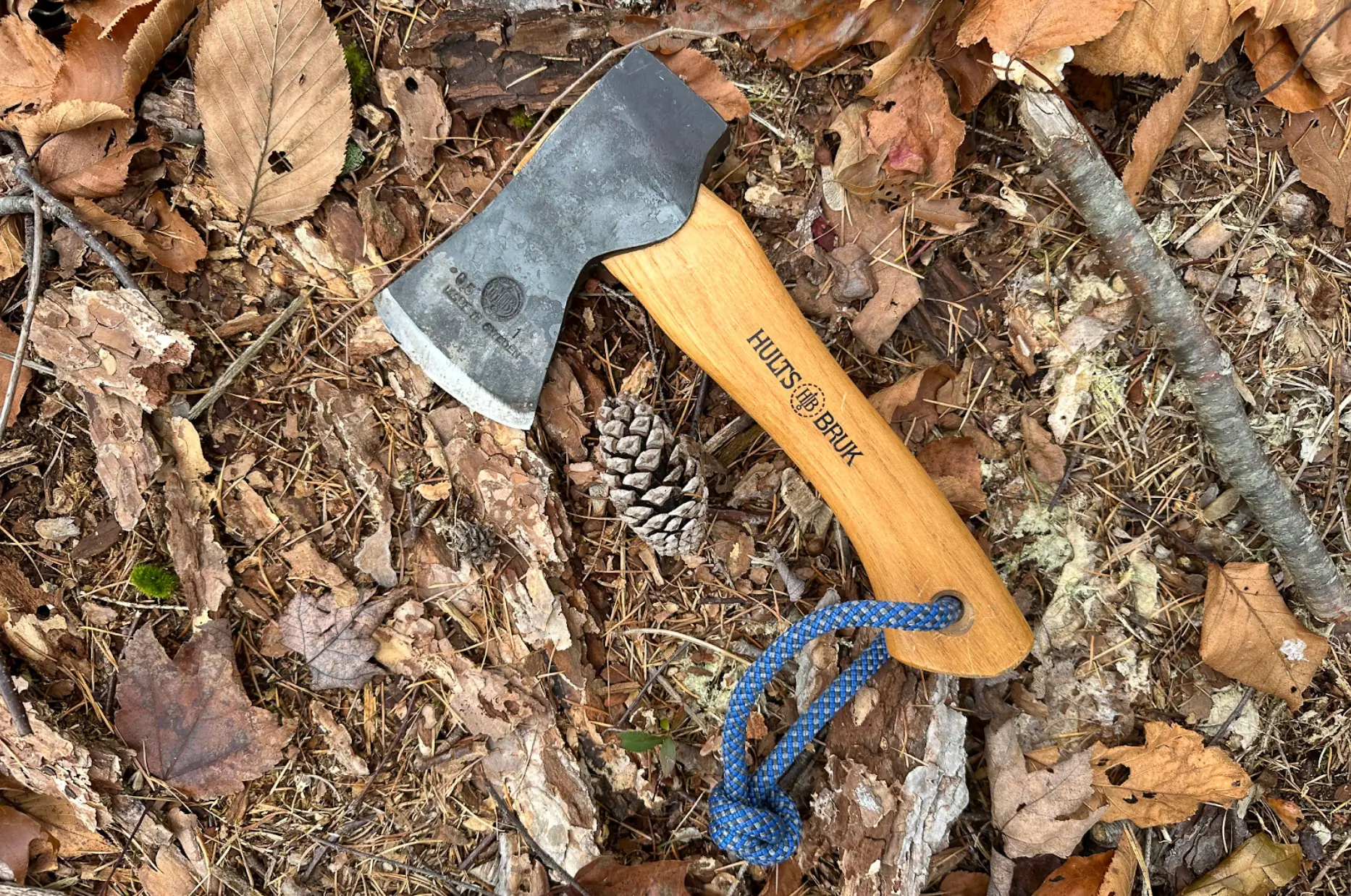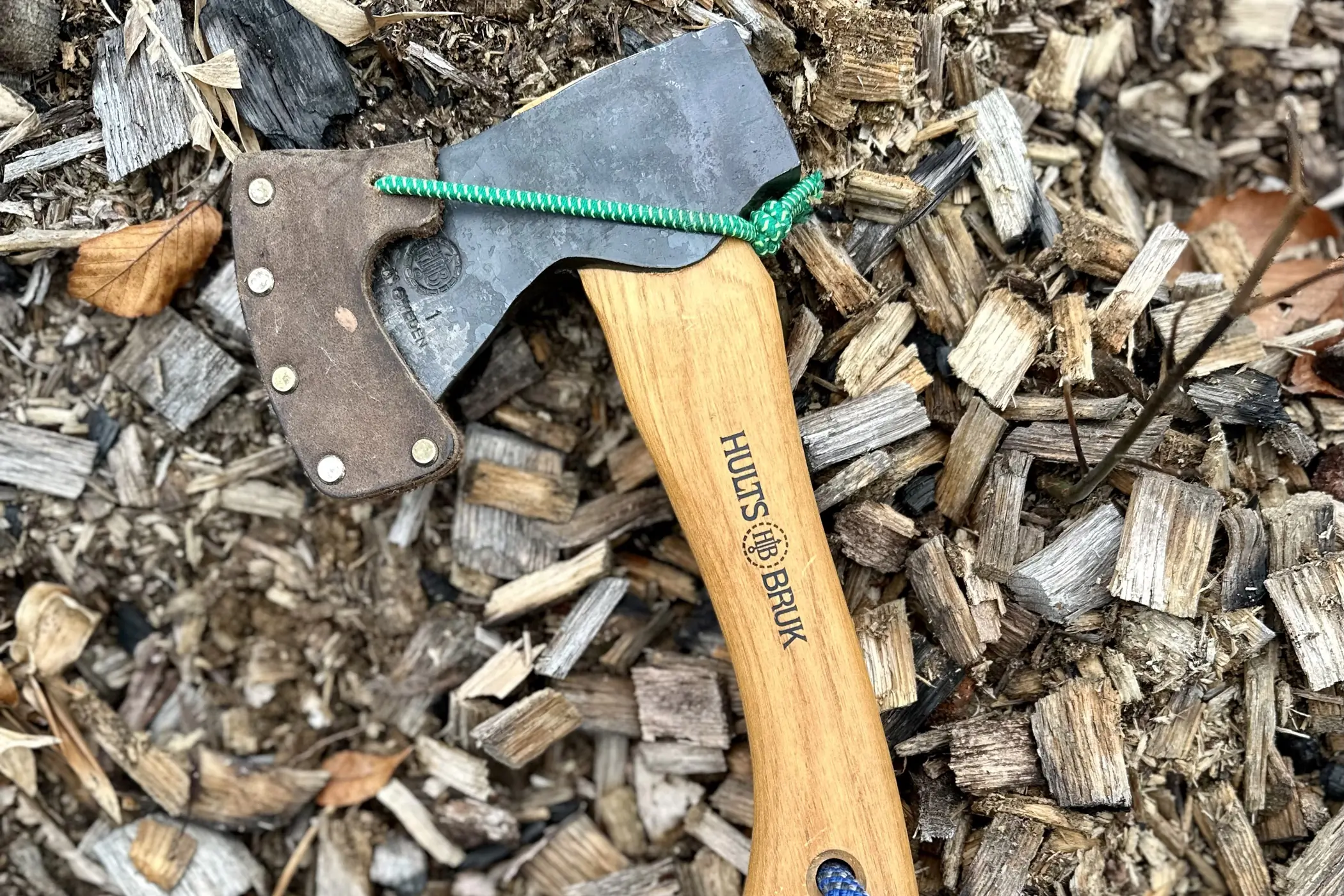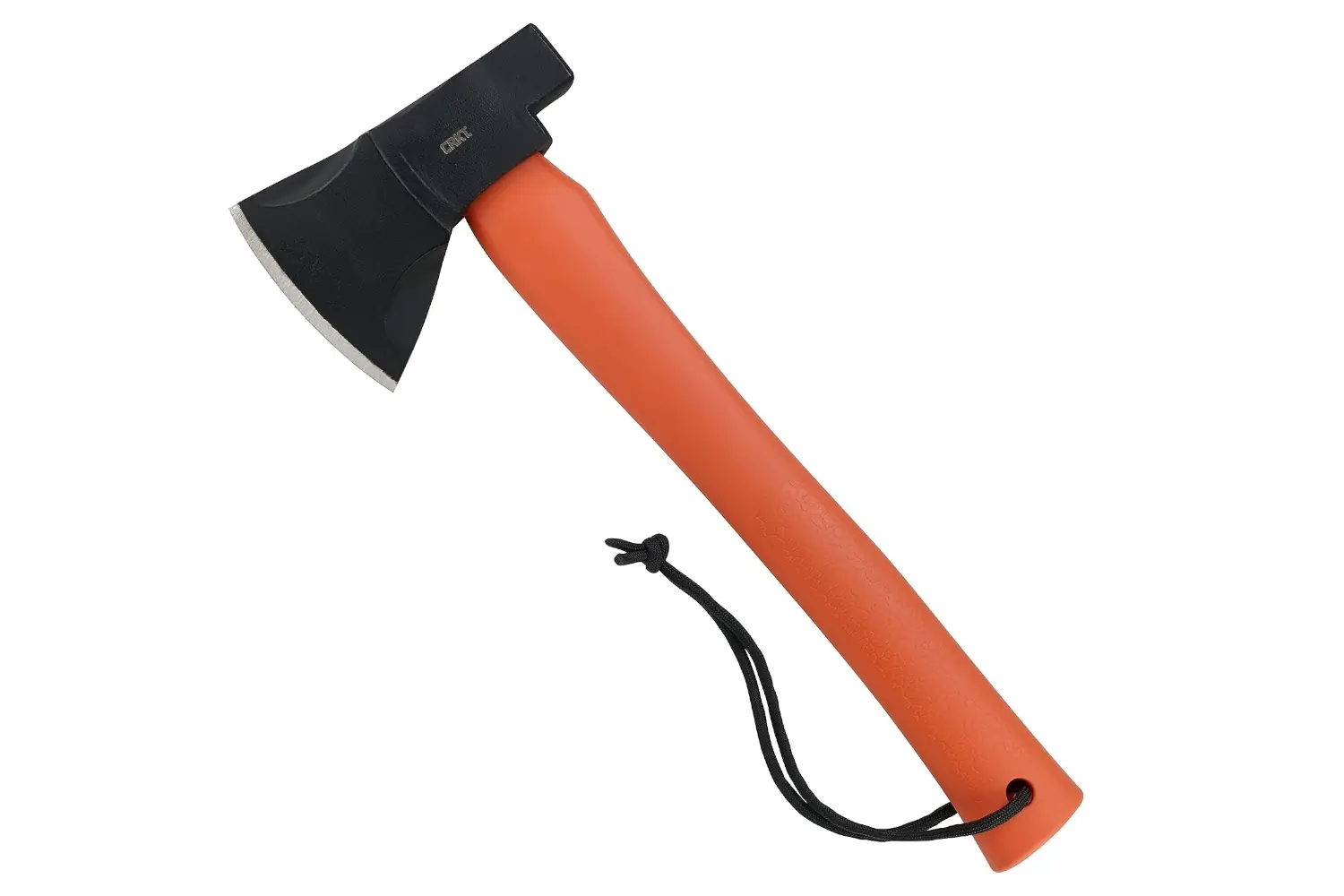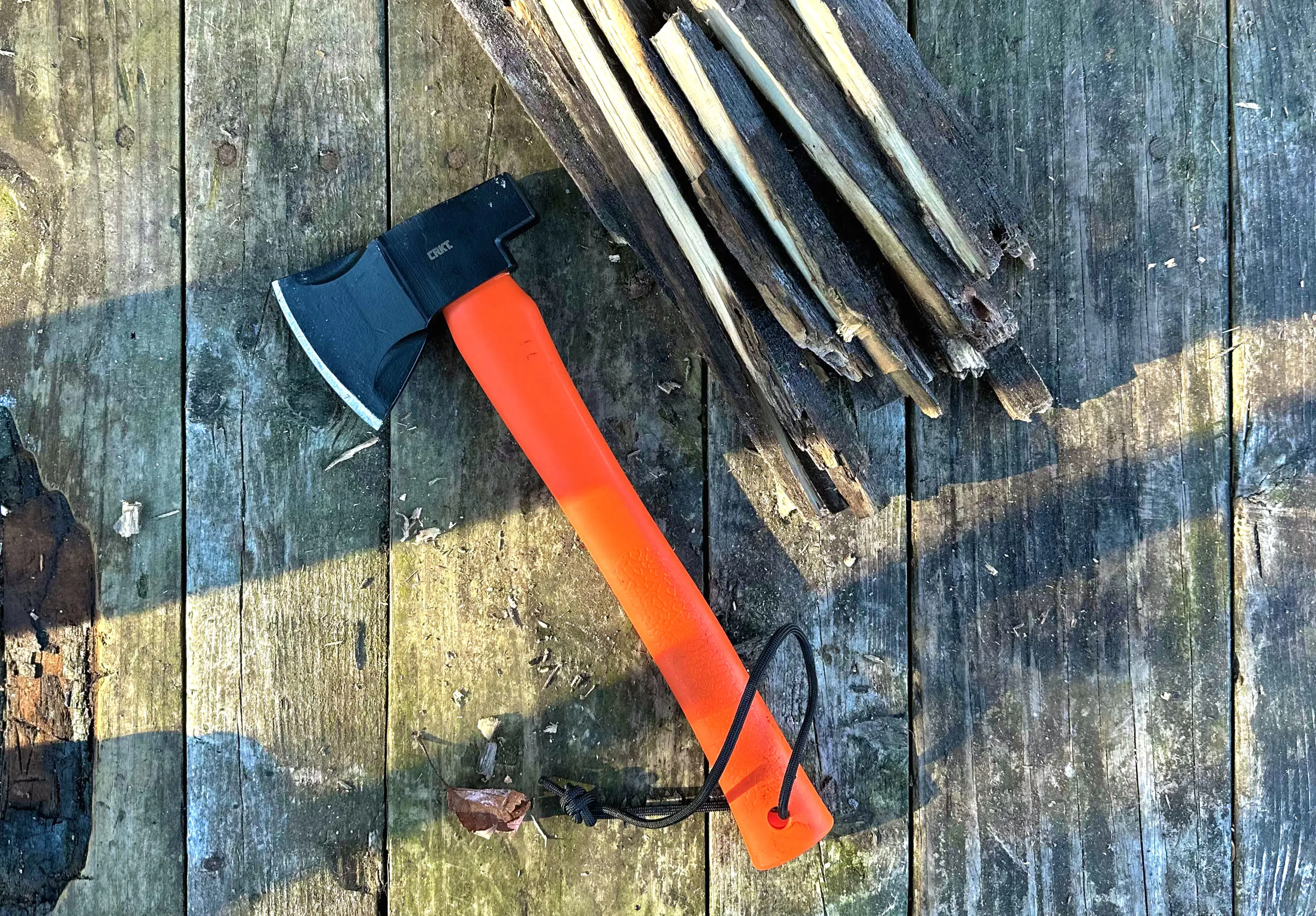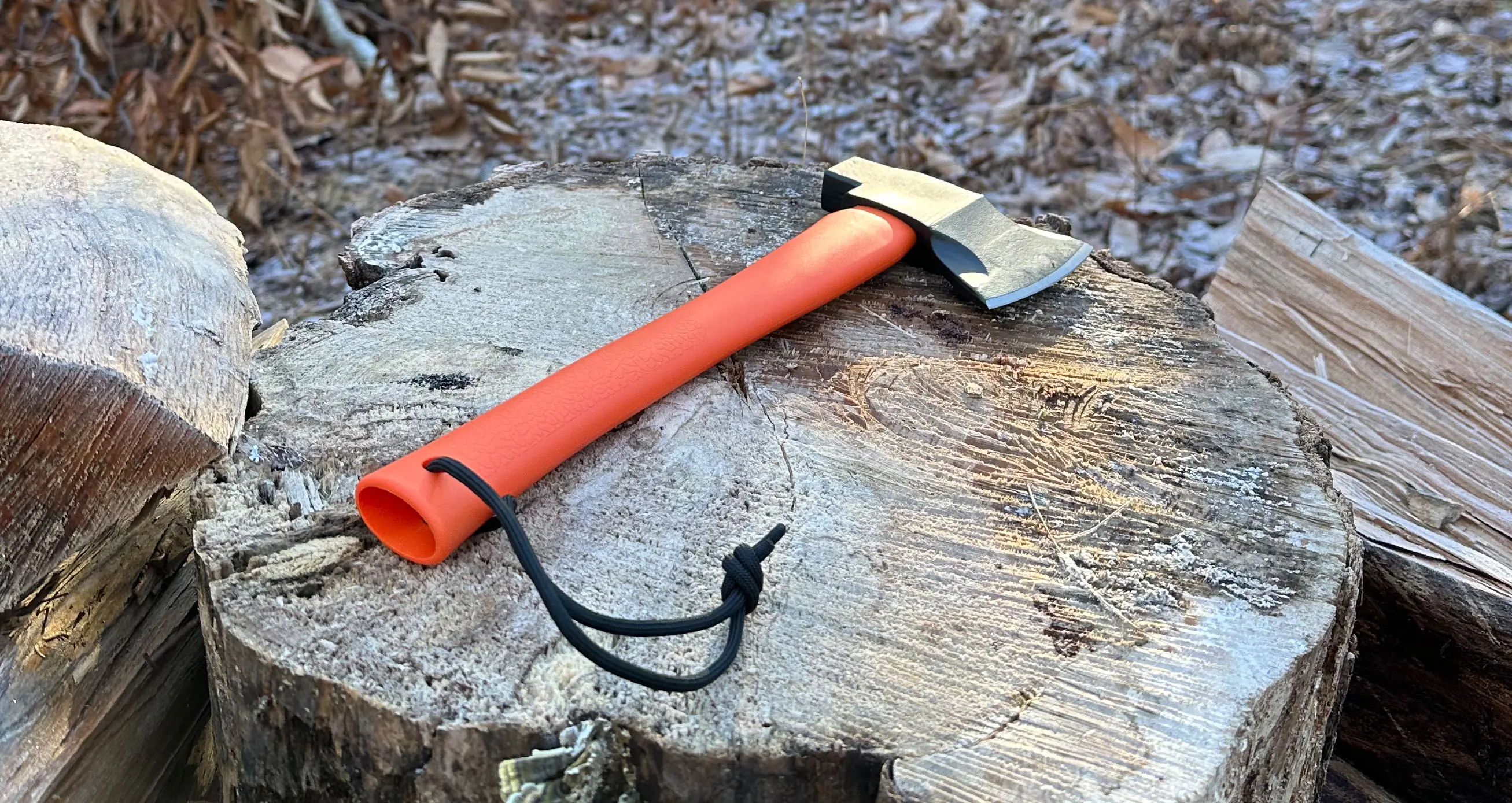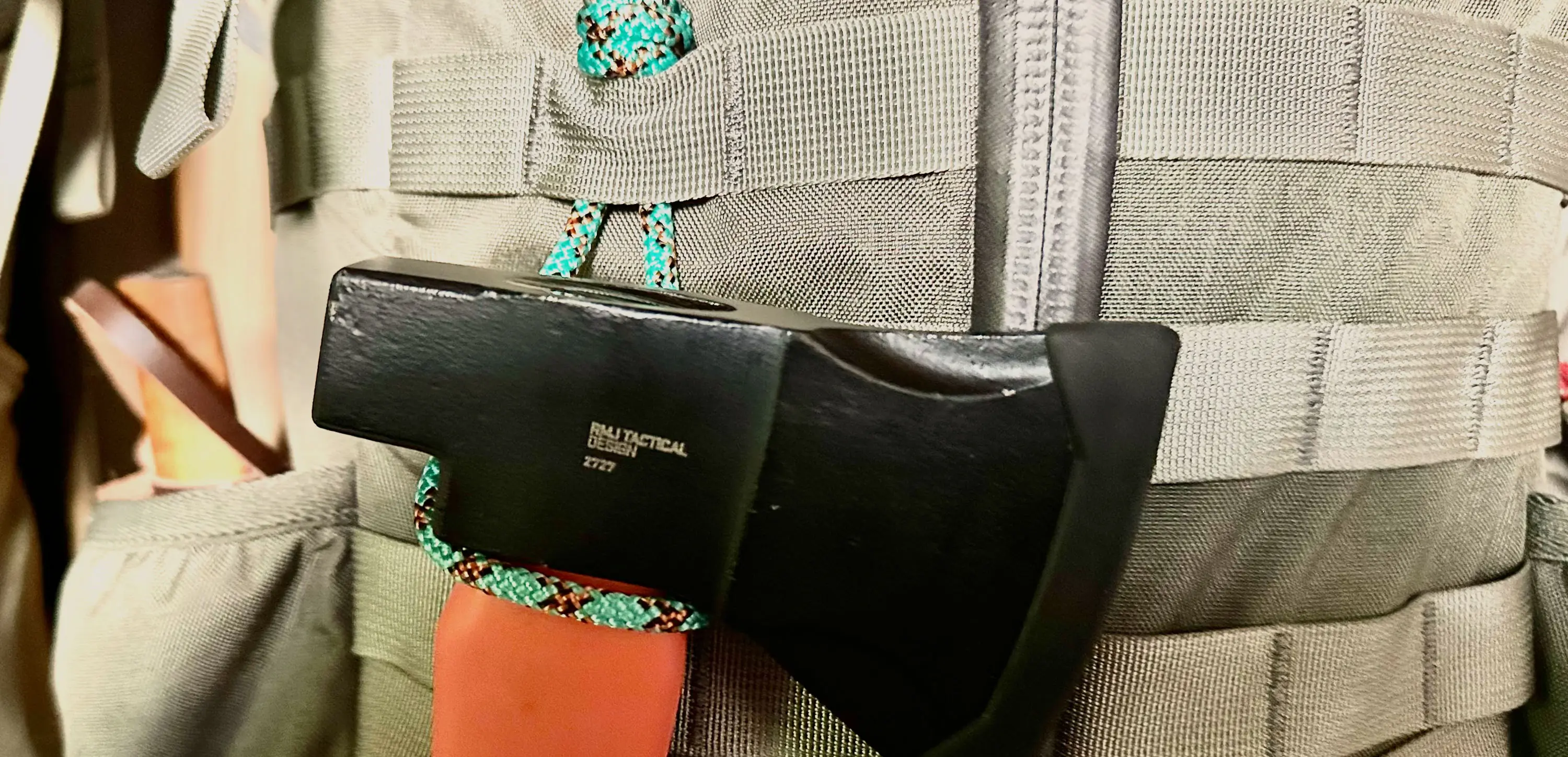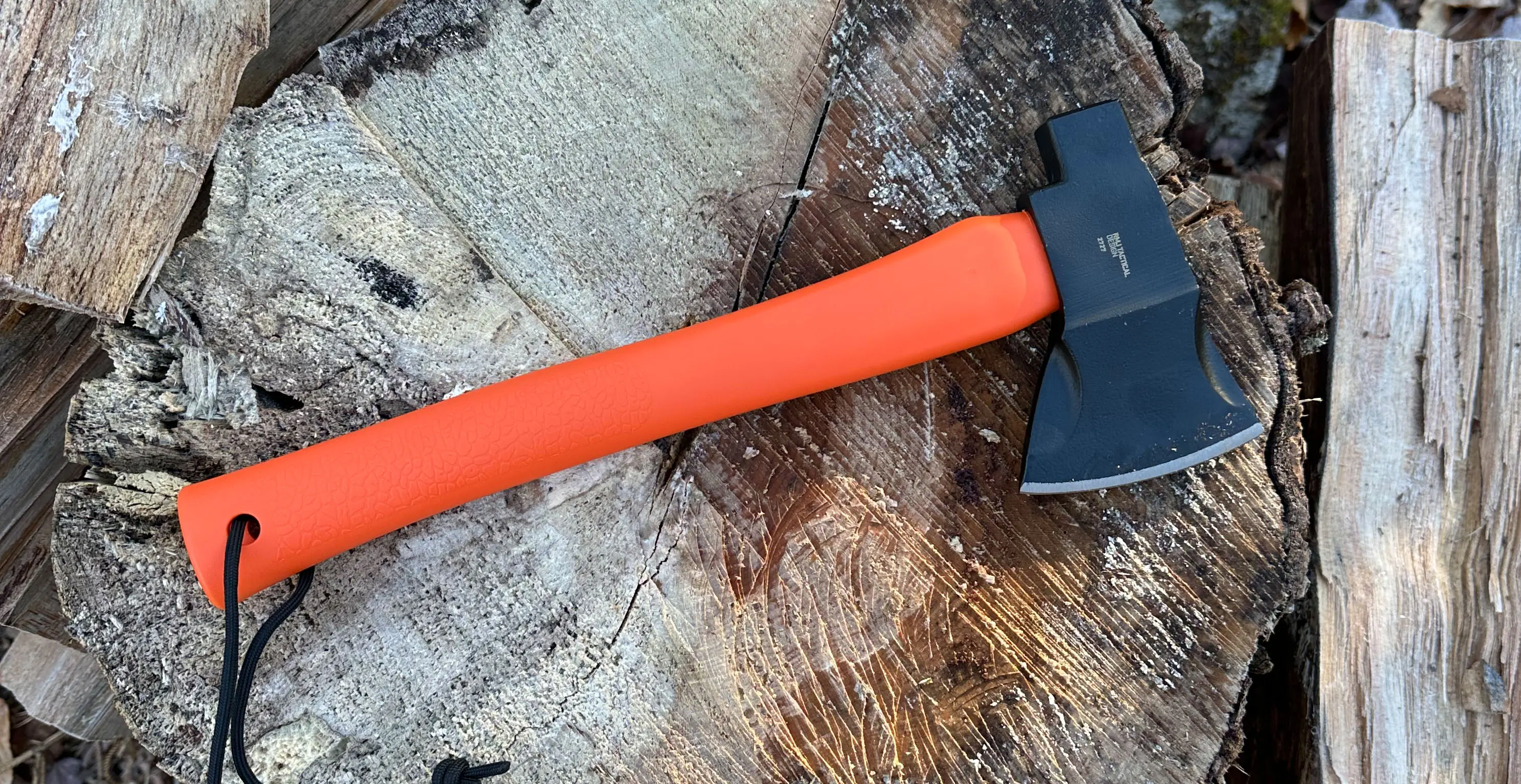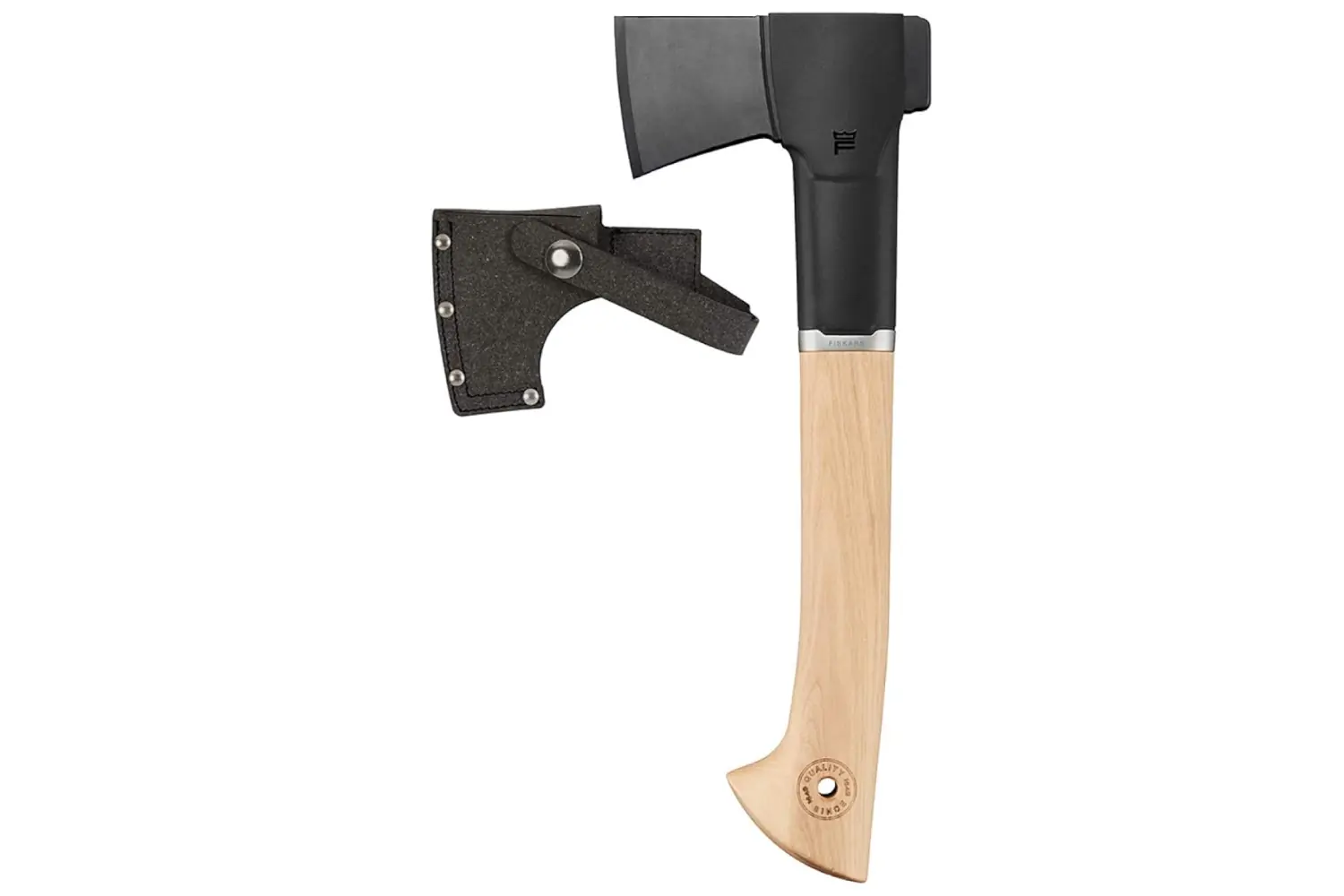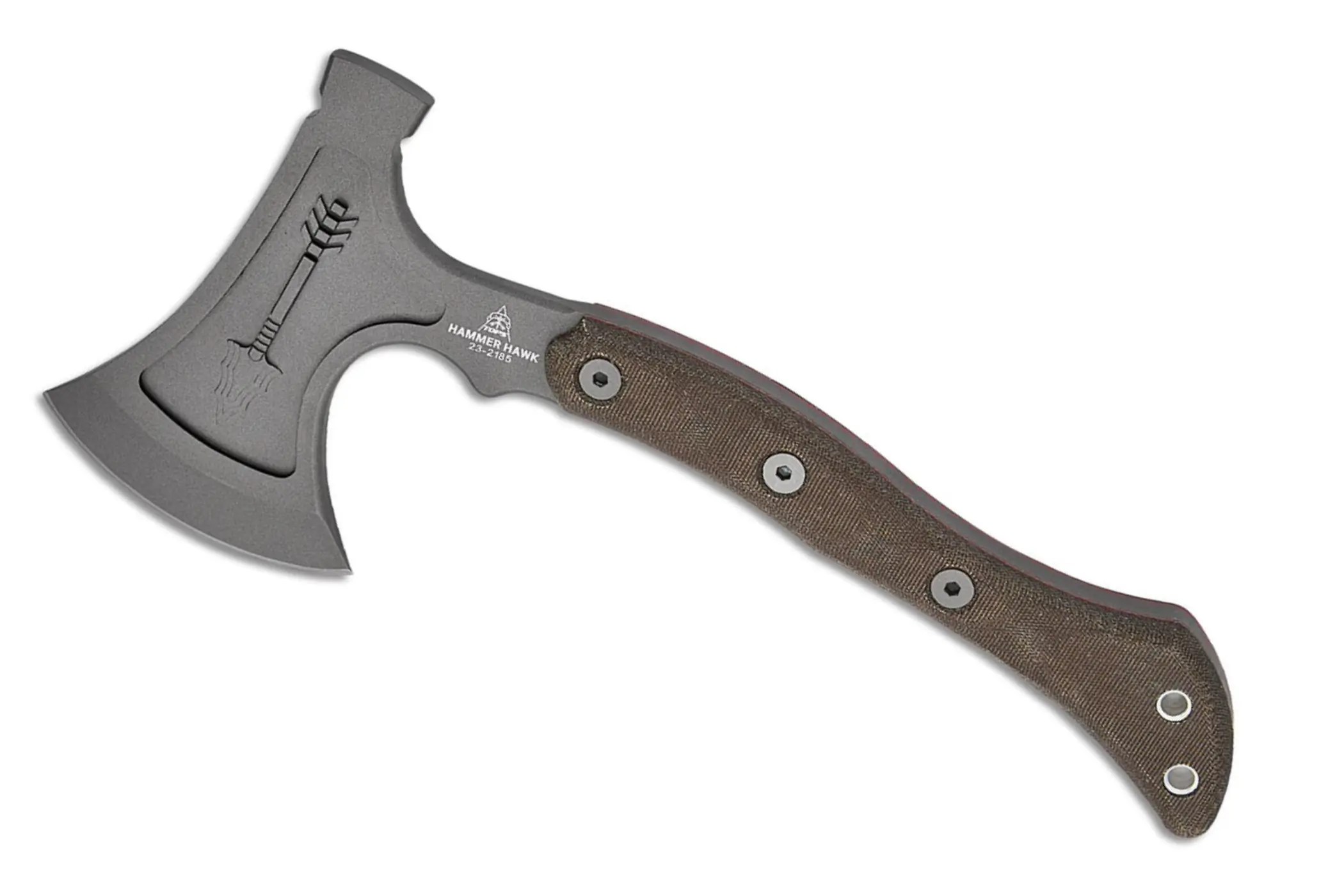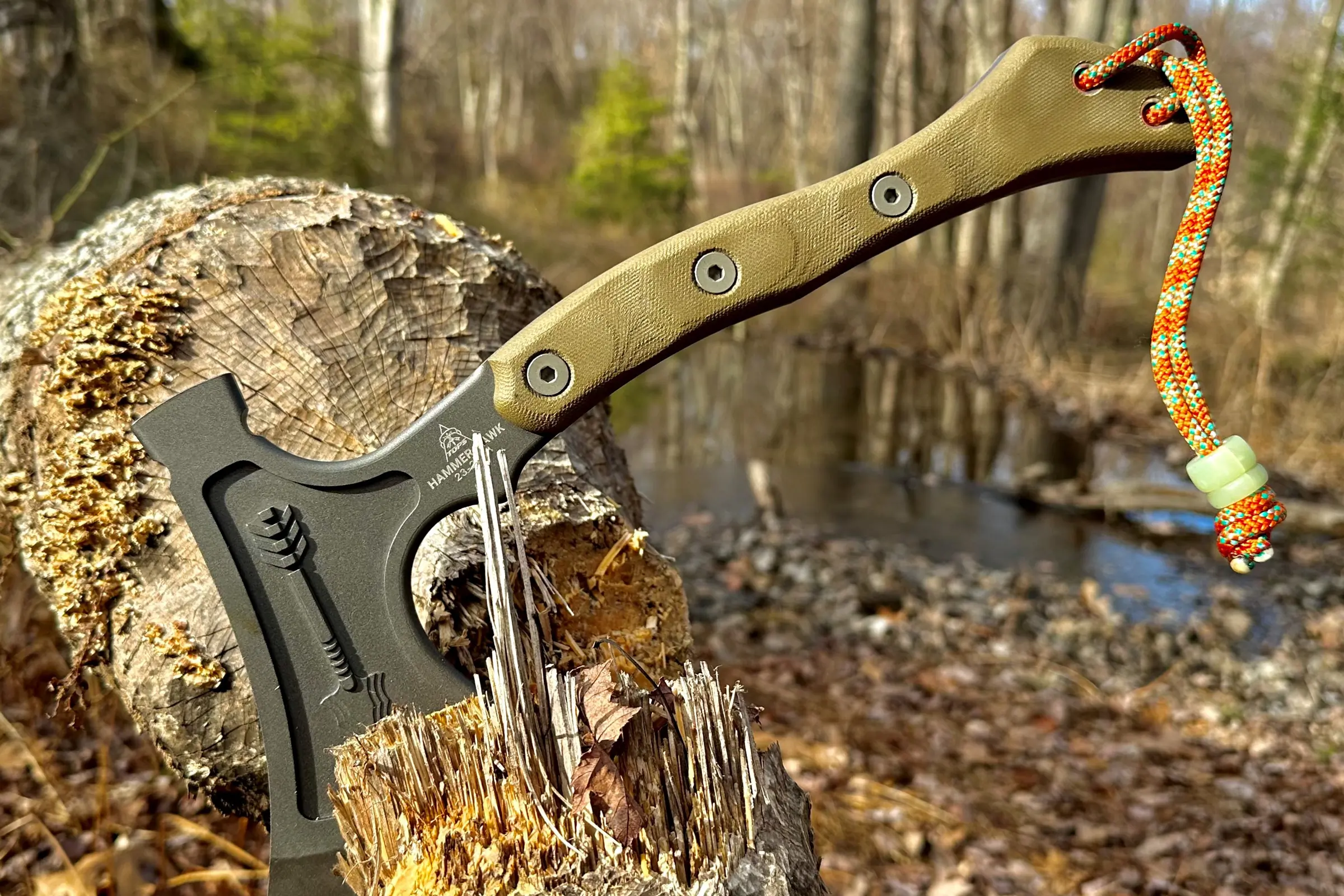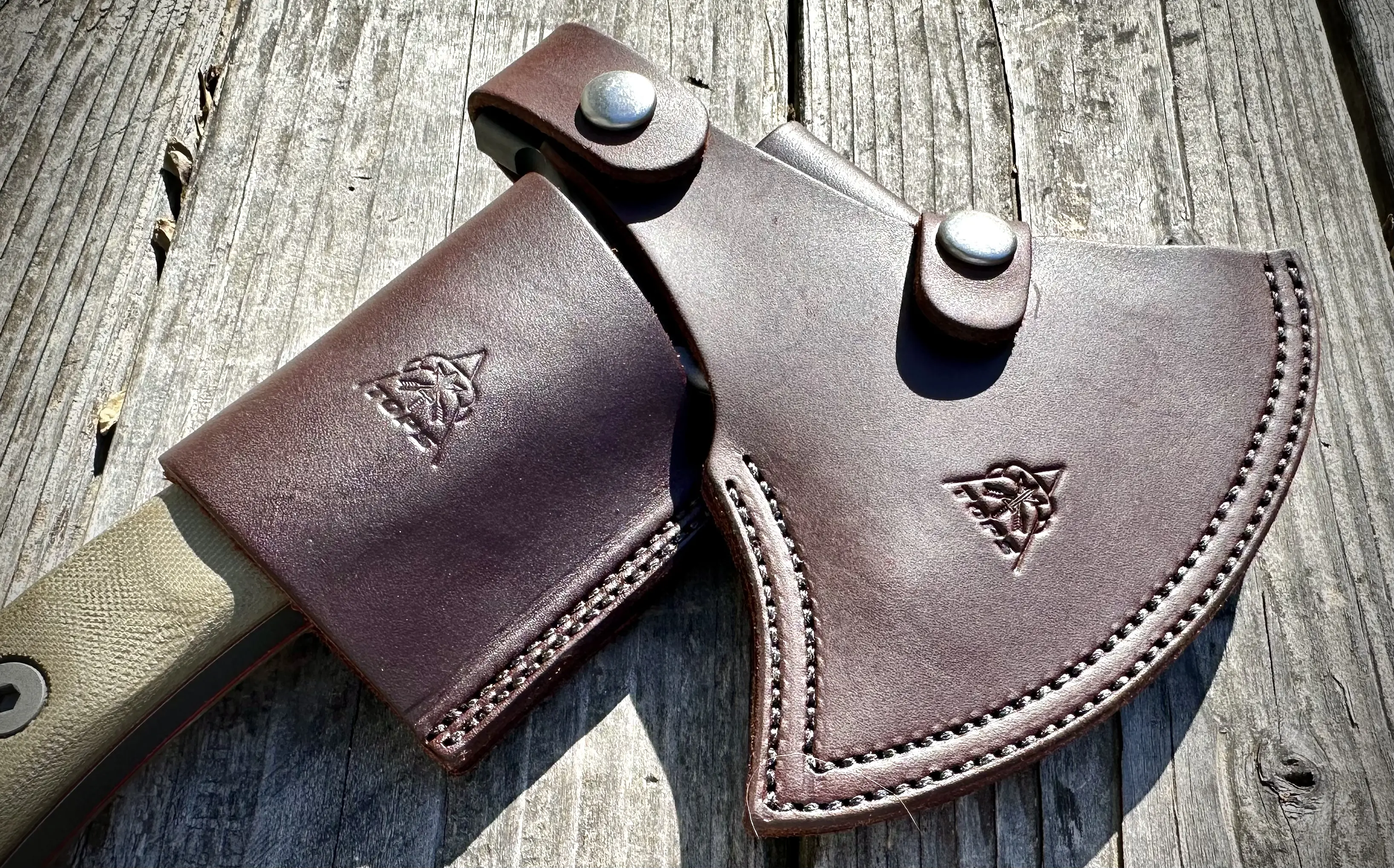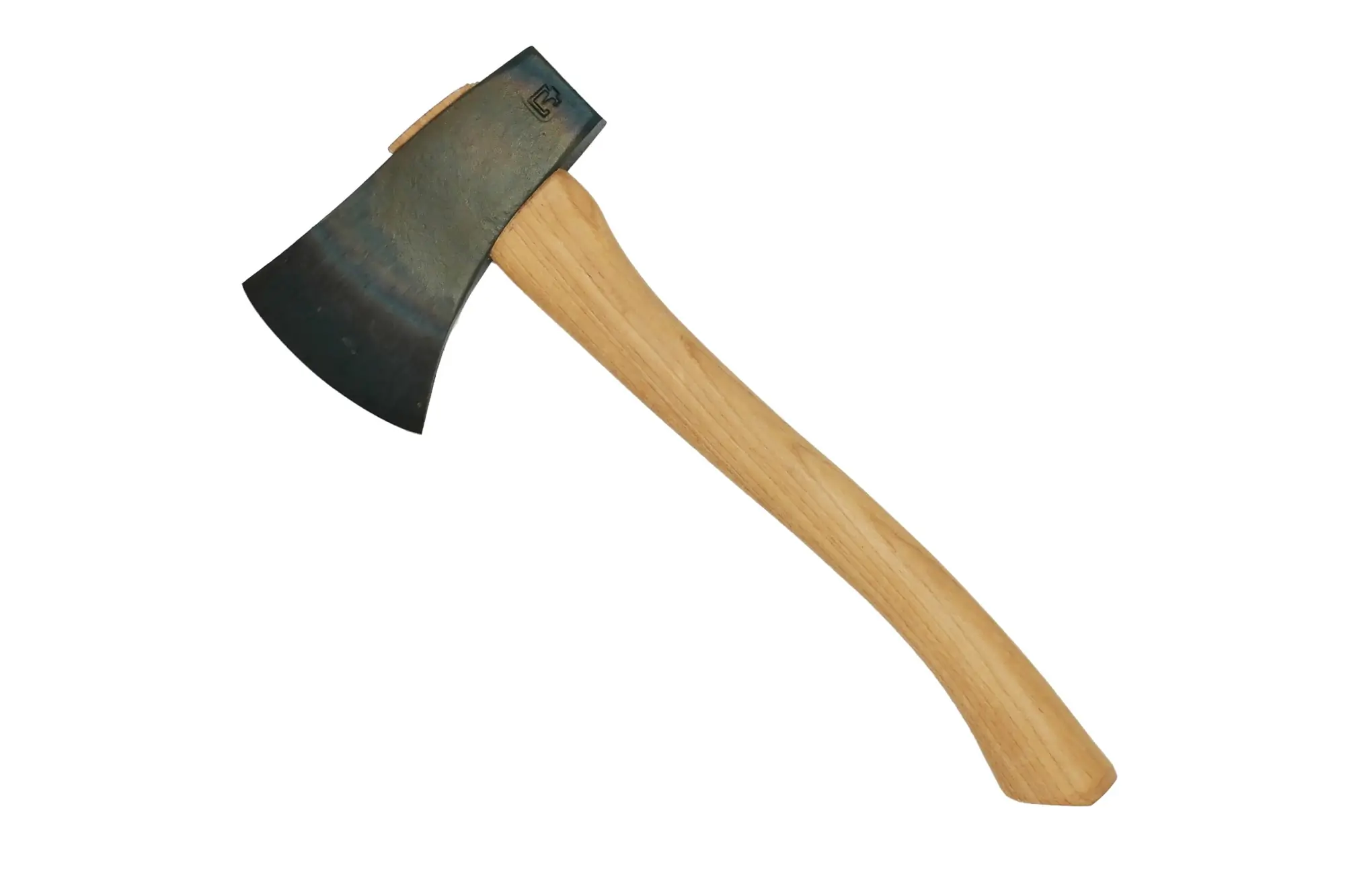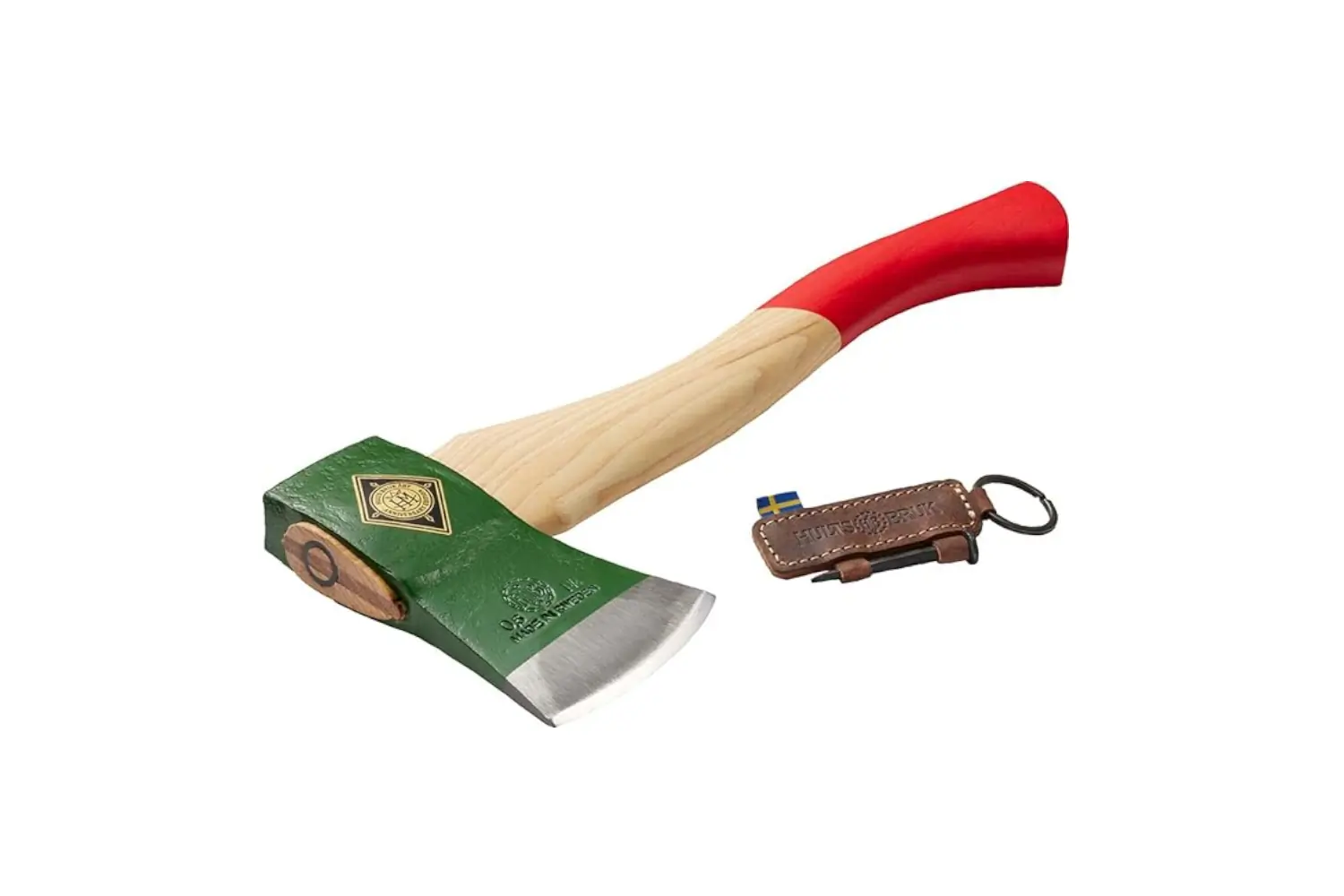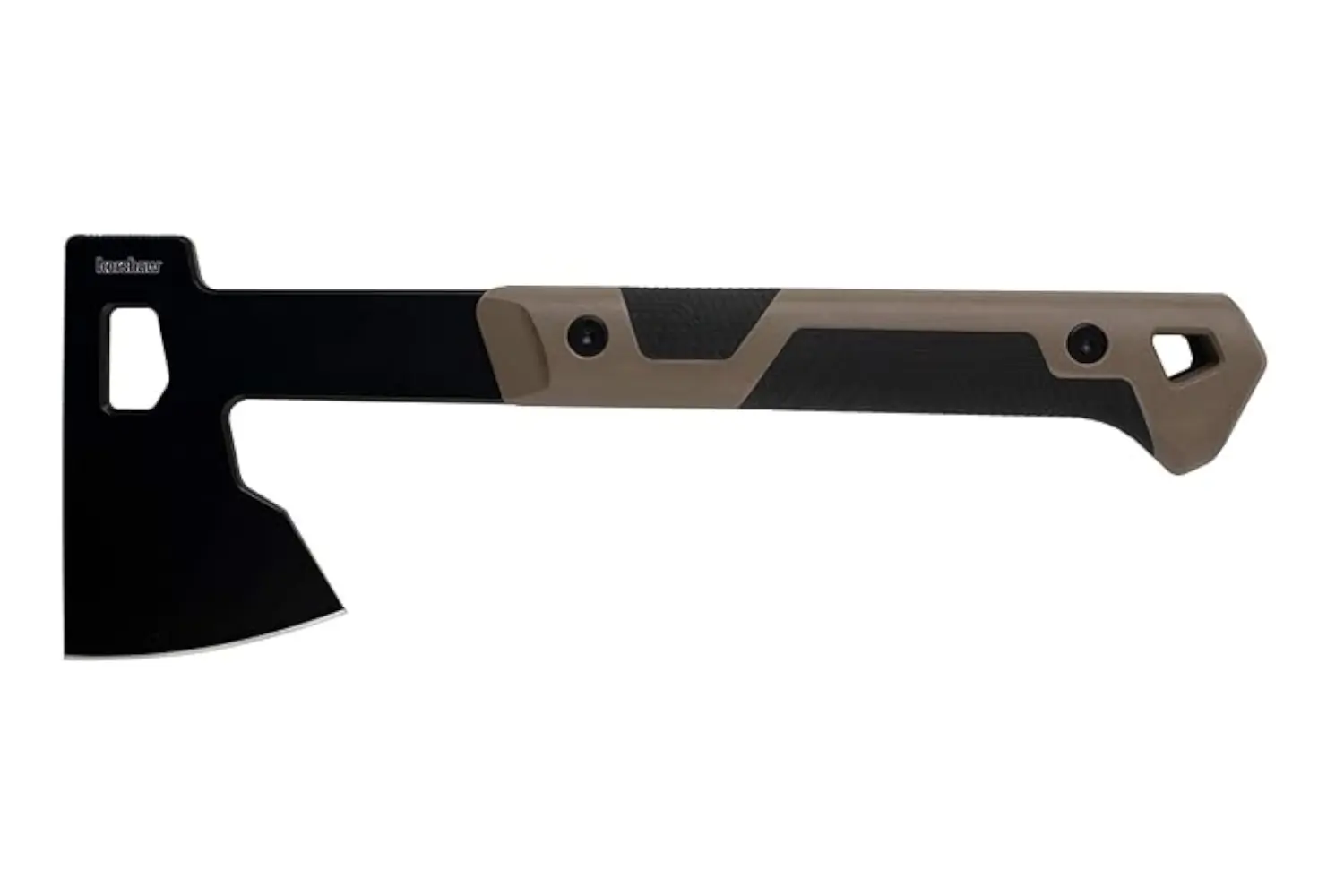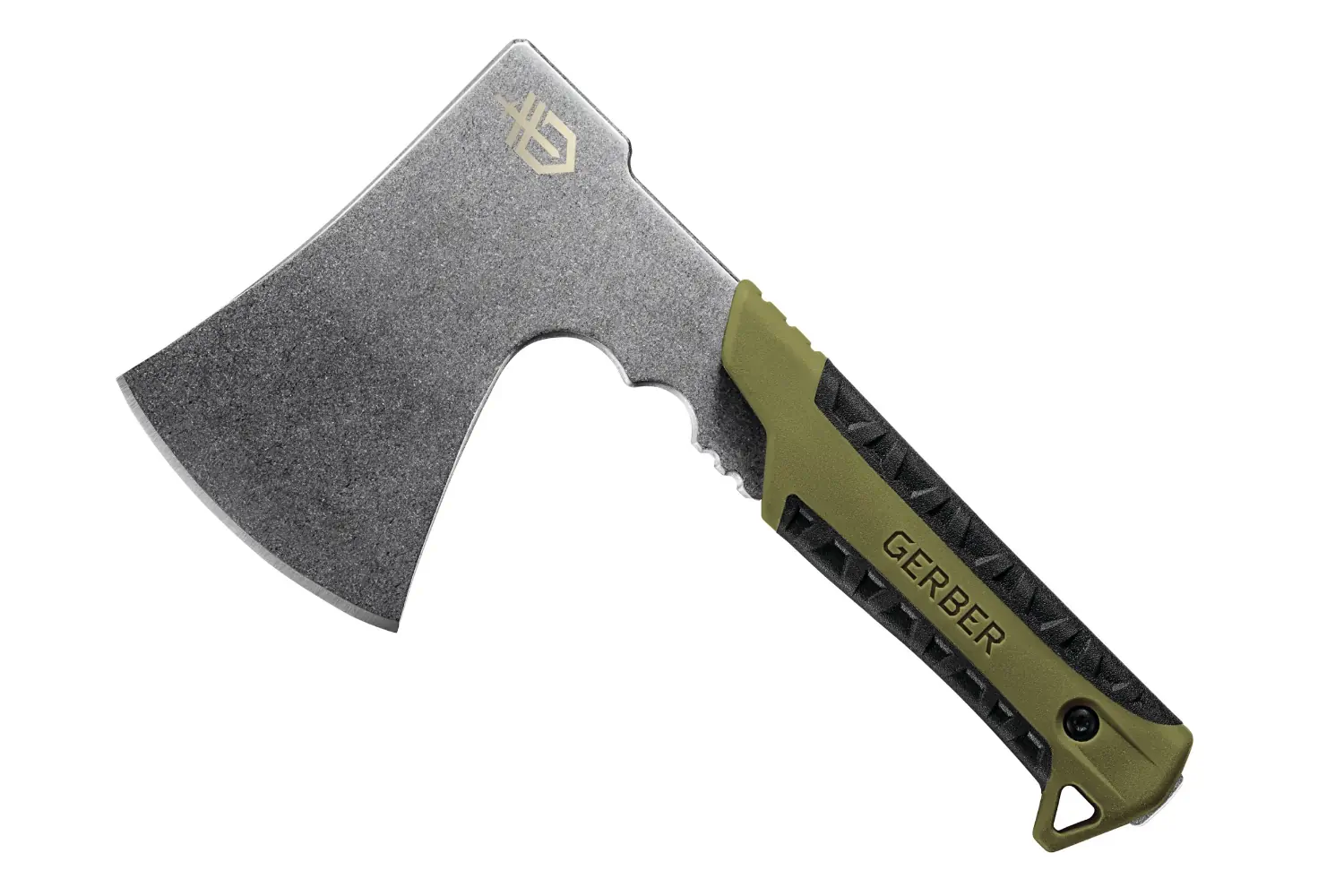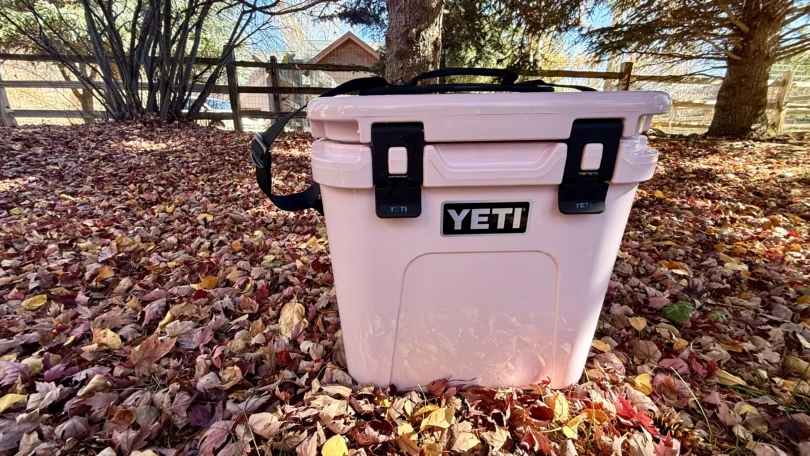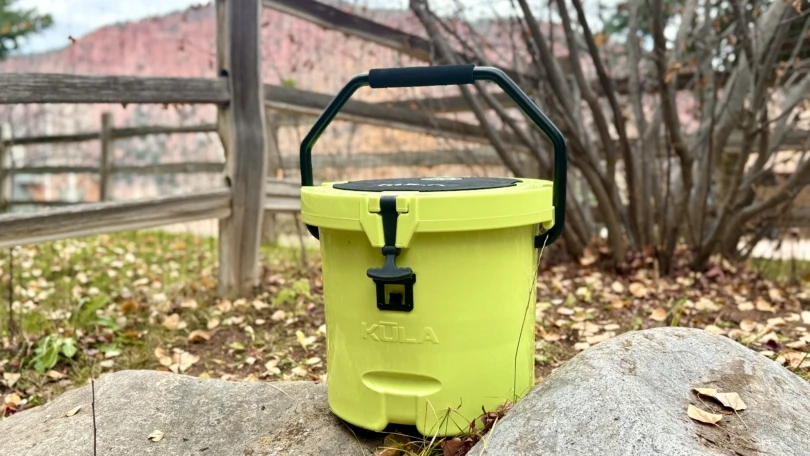While there are a million ways to camp and as many tools for the job, there is a solid case for keeping things simple with a classic camp hatchet. Lightweight, capable, and just dang fun to swing, the best camping hatchets are versatile tools for outdoor adventures, and we’ve swung the most worthy of stocking your kit.
Whether you need a tool to pound tent stakes or split wood, take a look at our list before making your decision. There are perfect all-around choppers like our top pick, the Hults Bruk Almike, as well as cheaper options to chuck in your truck kit, like the Husqvarna Swedish Style Hatchet. Our experts have been whittling, chopping, and splitting for half a decade now, and have tested more than 30 different hatchets across the backwoods of the U.S.
And we’re not just talking wall hangers here, either. Every hatchet is put through our rigorous testing regimen in order to test its ability to process wood, do fine work while carving, clear trails, and be a backcountry companion. Our experts are backcountry trail crew leaders, blade-industry old hands, and just everyday outdoors folk, and we feel confident in every one of the tools below.
Editor’s Note: We updated our Camping Hatchets guide on October 14, 2025, to add a new section on hatchet maintenance, detailed rating attributes to each suggestion, and a shake-up to our award winners.
The Best Camping Hatchets of 2025
Hults Bruk Almike
-
Cut Quality
9.0
-
Swing Feel
8.0
-
Ease of Maintenance
8.0
-
Durability
8.0
- Weight: 1 lb., 12 oz.
- Overall Length: 16"
- Head Length: 3"
- Steel Type: Hand-forged Swedish steel
- Handle Material: American hickory
Pros
- Functional design
- Incredibly durable
- Holds edge even after many uses
- Exceptionally sharp blade out of the box
Cons
- A bit long for a camp hatchet; not as portable
- One of the most expensive hatchets on our list
- Hand-forged steel can sometimes lead to uneven grinding
Husqvarna Swedish Style Hatchet
-
Cut Quality
8.0
-
Swing Feel
6.0
-
Ease of Maintenance
7.0
-
Durability
7.0
- Weight: 2 lb., 2 oz.
- Overall Length: 15"
- Bit Length: 3.3"
- Steel type: Hand-forged Swedish steel
- Handle Material: Hickory
Pros
- Budget price with great value
- Classic design and build
- Hand-forged Swedish steel
- Good handle ergonomics
Cons
- Doesn’t come with a full sheath
- Head-heavy swing weight, which takes some getting used to
Gerber Bushcraft Hatchet
-
Cut Quality
8.0
-
Swing Feel
8.0
-
Ease of Maintenance
7.0
-
Durability
7.0
- Weight: 2 lbs., 6.4 oz.
- Overall Length: 15.2"
- Head Length: 5.5"
- Steel Type: Forged & coated 1055 stainless steel
- Handle Material: Synthetic polymer with rubberized inserts
Pros
- Reliefs in head allow for easier penetration
- Advanced handle ergonomics and shock reduction
- Internal stash sleeve holds paracord and mini lighter survival tools
- Hammer poll is well sized and accurate to swing
Cons
- Much more of a splitter than a carver
- Doesn’t come well sharpened from the factory
- Fairly hefty at 2.5 pounds
Fiskars X7
-
Cut Quality
7.0
-
Swing Feel
6.0
-
Ease of Maintenance
7.0
-
Durability
6.0
- Weight: 1 lb., 6 oz.
- Overall Length: 14"
- Head Length: 5"
- Steel Type: Hardened forged carbon steel
- Handle Material: FiberComp composite
Pros
- Highly affordable
- Suitable for splitting kindling or small logs
- Relatively lightweight design
- Integrated handle protects bit during transport
Cons
- Head-forward swing weight balance
- Concerns about blade chipping
- Requires more regular maintenance to keep in prime condition
Gränsfors Bruk Wildlife Hatchet
-
Cut Quality
9.0
-
Swing Feel
8.0
-
Ease of Maintenance
8.0
-
Durability
8.0
- Weight: 1 lb., 4.8 oz.
- Overall Length: 13.7"
- Head Length: 4"
- Steel Type: Recycled steel
- Handle Material: Hickory
Pros
- Blacksmith-forged head with stamped initials
- Polished cutting edge
- Quality vegetable-tanned leather sheath
- Fine carving abilities
Cons
- Price
- Simple fit and finish
- Can be more difficult to source on this side of the pond
Hardcore Hammers Camp Companion Axe
-
Cut Quality
9.0
-
Swing Feel
8.0
-
Ease of Maintenance
8.0
-
Durability
9.0
- Weight: 2 lbs., 5 oz.
- Overall Length: 16”
- Bit Length: 3.75”
- Steel Type: Black FNC-coated 4140
- Handle Material: Hickory
Pros
- Balance between size and weight
- FNC coating on the head
- Hammer size
- Quality construction
Cons
- Leather sheath can be very tight at first
- Higher price than many
Hults Bruk Jonaker
-
Cut Quality
7.0
-
Swing Feel
6.0
-
Ease of Maintenance
7.0
-
Durability
8.0
- Weight: 1 lb., 5 oz.
- Overall Length: 9.4"
- Bit Length: 2.8"
- Steel Type: Hand-forged Swedish steel
- Handle Material: Hickory
Pros
- Hand-forged Swedish steel head
- Leather sheath can be used to hook the Jonaker to your belt
- Blackened finish that reduces friction and increases corrosion resistance
- Enough heft behind it to get some good chopping power
Cons
- Pricey for the size
- Smaller size will be limiting for bigger jobs
Other Hatchets We Trust in the Backcountry
We’ve swung a lot of hatchets in our time, and the lineup above are the tools we trust the most to get the job done — whatever that may be. That said, there are many others we’ve come to enjoy using at camp, on the trail, and while stacking cords of wood. Check out our runner-up options below.
-
Cut Quality
7.0
-
Swing Feel
7.0
-
Ease of Maintenance
7.0
-
Durability
8.0
- Weight: 1 lb., 5 oz.
- Overall Length: 13.2"
- Bit Length: 3.2"
- Steel Type: Manganese phosphate coated 1055 carbon steel
- Handle Material: Glass-reinforced nylon
Pros
- Lightweight but effective
- Forged 1055 carbon steel head for long-term abuse
- Glass-reinforced nylon handle is tough
- Broad hammer poll surface area
Cons
- Doesn’t come with a sheath
- Ideally suited for splitting kindling, not much bigger
-
Cut Quality
8.0
-
Swing Feel
7.0
-
Ease of Maintenance
7.0
-
Durability
8.0
- Weight: 1 lb., 7 oz.
- Overall Length: 15"
- Bit Length: 2.6"
- Steel Type: Carbon steel with low friction coating
- Handle Material: Hickory
Pros
- FiberComp overstrike protection
- Low-friction bit coating
- Balanced weight
- Palm swell on handle cradles the hand well
Cons
- The recycled leather sheath isn't the nicest
- On the pricier side for an everyday hatchet
-
Cut Quality
7.0
-
Swing Feel
7.0
-
Ease of Maintenance
8.0
-
Durability
9.0
- Weight: 2 lbs., 3 oz.
- Overall Length: 14.5"
- Head Length: 4.5"
- Steel Type: ⅜” 1075 carbon steel with tungsten Cerakote finish
- Handle Material: Canvas Micarta
Pros
- Single piece construction
- Cerakote finish and Micarta handle
- Massive 4.5” blade
- Advanced ergonomics
- Well balanced
Cons
- The hammer could be thicker
- Most of the knives we own are too big for the slot in the belt frog
-
Cut Quality
7.0
-
Swing Feel
8.0
-
Ease of Maintenance
7.0
-
Durability
8.0
- Weight: 2 lbs., 4 oz.
- Length: 15.5"
- Bit Length: 3.88"
- Steel Type: 1060 steel
- Handle Material: American hickory
Pros
- Hardened bit and poll
- Ergonomic shape for prolonged use
- Great balance
- Under $75
Cons
- Doesn’t come with a sheath as standard
- Stickers on the handle leave a lot of residue behind
-
Cut Quality
8.0
-
Swing Feel
6.0
-
Ease of Maintenance
7.0
-
Durability
7.0
- Weight: 2 lbs., 2 oz.
- Overall Length: 15.2"
- Bit Length: 3.3"
- Steel Type: Hand-forged Swedish steel
- Handle Material: American hickory
Pros
- Beautiful design
- Ergonomic design promotes comfort and safety when in use
- High-quality construction
- 325 years of heritage
Cons
- More expensive than other options
- Heavier than many
-
Cut Quality
7.0
-
Swing Feel
7.0
-
Ease of Maintenance
6.0
-
Durability
6.0
- Weight: 1 lb., 9 oz.
- Overall Length: 14"
- Bit Length: 3.5"
- Steel Type: Black oxide coated 3Cr13
- Handle Material: Glass-filled nylon with rubber overlay
Pros
- 0.24” thickness makes for easy cutting
- Innovative sheath with carry strap
- Swing weight is balanced across the entire hatchet
- Black oxide blade coating keeps it moving through material
Cons
- Too thin to hammer with
- 3Cr13 is a bit soft for a steel, and will need more upkeep to stay sharp
-
Cut Quality
6.0
-
Swing Feel
6.0
-
Ease of Maintenance
7.0
-
Durability
6.0
- Weight: 1 lb., 8.5 oz.
- Overall Length: 9.5"
- Head Length: 3.5"
- Steel Type: Stainless 3Cr13MoV steel
- Handle Material: Rubber/composite overmold
Pros
- Compact packed size
- Tall grind maintains sharpness
- Finger grooves for choking up on fine detail work
- Great for uses of all experience and dedication levels
Cons
- Less durable sheath
- Not meant for bigger jobs
-
Cut Quality
7.0
-
Swing Feel
6.0
-
Ease of Maintenance
7.0
-
Durability
7.0
- Weight: 1 lb., 14.4 oz.
- Overall Length: 14"
- Head Length: 4"
- Steel Type: C45 steel
- Handle Material: U.S. hickory
Pros
- Beautiful design
- Ergonomic design promotes comfort and safety when in use
- High-quality construction
- Eco-friendly manufacturing
Cons
- More expensive than other options
- Unique shape of axe head takes a bit getting used to
- Heavier than other options
- Not the best for backpacking
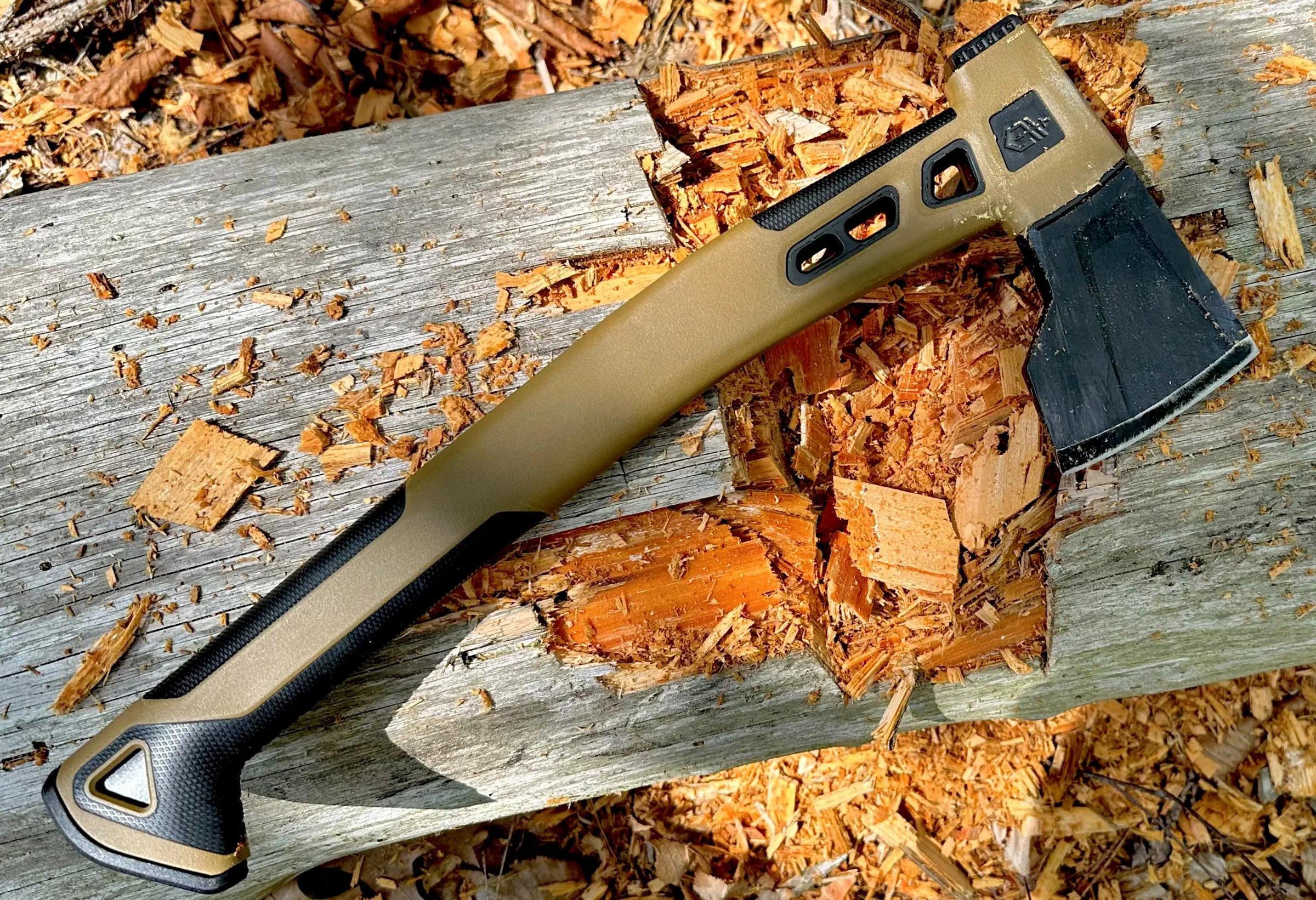
Camping Hatchet Comparison Chart
| Camping Hatchet | Price | Weight | Overall Length | Steel Type | Handle Material |
|---|---|---|---|---|---|
| Hults Bruk Almike | $199 | 1 lb., 12 oz. | 16″ | Hand-forged Swedish steel | American hickory |
| Husqvarna Swedish Style Hatchet | $70 | 2 lb., 2 oz. | 15″ | Hand-forged Swedish Steel | Hickory |
| Gerber Bushcraft Hatchet | $70 | 2 lbs., 6.4 oz. | 15.2″ | Forged & coated 1055 stainless steel | Synthetic polymer with rubberized inserts |
| Fiskars X7 | $35 | 1 lb., 6 oz. | 14″ | Hardened forged carbon steel | FiberComp composite |
| Gränsfors Bruk Wildlife Hatchet | $185 | 1 lb., 4.8 oz. | 13.7″ | Recycled hand-forged Swedish steel | Hickory |
| Hardcore Hammers Camp Companion | $200 | 2 lbs., 5 oz. | 16″ | Black FNC coated 4140 | Hickory |
| Hults Bruk Jonaker | $189 | 1 lb., 5 oz. | 9.4″ | Hand-forged Swedish steel | Hickory |
| CRKT Chogan Hatchet | $65 | 1 lb., 5 oz. | 13.1″ | 1055 carbon steel | Glass-reinforced nylon |
| Fiskars Norden N7 Hatchet | $120 | 1 lb., 7 oz. | 15″ | Carbon steel with low friction coating | Hickory |
| TOPS Hammer Hawk | $530 | 2 lbs., 3 oz. | 14.5″ | 1075 carbon steel with tungsten Cerakote finish | Canvas Micarta |
| Council Tools Flying Fox Woodsman | $67 | 2 lbs., 4 oz. | 15.5″ | 1060 steel | American hickory |
| Hults Bruk 325-Year Anniversary Axe | $184 | 2 lbs., 2 oz. | 15.2″ | Hand-forged Swedish steel | American hickory |
| Kershaw Deschutes | $103 | 1 lb., 9 oz. | 14″ | Carbon steel with low-friction coating | Glass-filled nylon with rubber overlay |
| Gerber Pack Hatchet | $45 | 1 lb., 8.5 oz. | 9.5″ | Stainless 3Cr13MoV steel | Rubber overmold |
| Adler Rheinland Hatchet | $98 | 1 lb., 14.4 oz. | 14″ | C45 steel | American hickory |
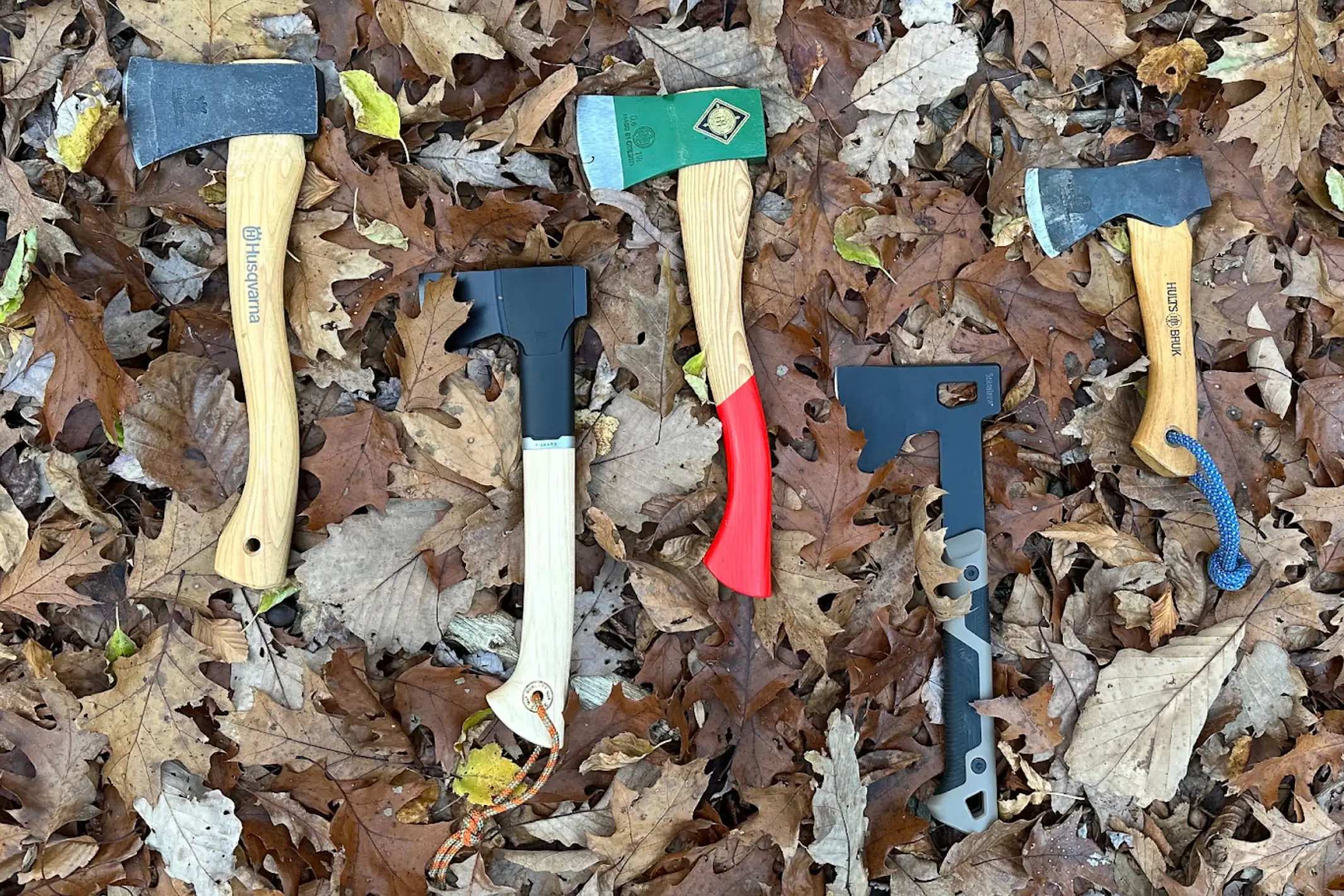



How We Tested the Best Camping Hatchets
GearJunkie’s camping hatchet testing covers both the real and the less-than-ideal situations in which you might find yourself with the tools.
- Field use: We use these hatchets to clear brush, process firewood, and make trails throughout an entire season before rendering a verdict. Our experts range from knife-industry experts to backcountry trail crew leaders.
- Balance and swing testing: Our method of testing a hatchet’s balance is to hold it at the base of the handle and let it swing down into a log or stump. If it glances off the wood, then the bit is either too dull or the head is too heavy and unbalanced against the length of the handle.
- Chop and edge testing: We process up to a dozen 3”-4” diameter logs and vary the species to hardwoods like birch and beech, and softwoods like pine and cedar. For half of the trials, the wood was wet and green. For the other half, we processed more seasoned wood.
- Weather resistance monitoring: All of the hatchets we’ve tested have been used hard and put away wet, and we monitor them for long-term durability from weather exposure.
- Our Hatchet Rating System: We take all of our in-field and bench testing feedback and use it to rate each hatchet on a set of four essential metrics:
- Cut quality: 30% weighted. How well does the hatchet chop through hardwood? Softwood?
- Swing feel: 30% weighted. Is the hatchet balanced? Does it have enough heft to clear cuts?
- Ease of maintenance: 20% weighted. Is the steel used easy to maintain? The handle or any covers?
- Durability: 20% weighted. Does the head come loose after a season of use? Has the bit chipped?
Our Testing Process and Testing Locations
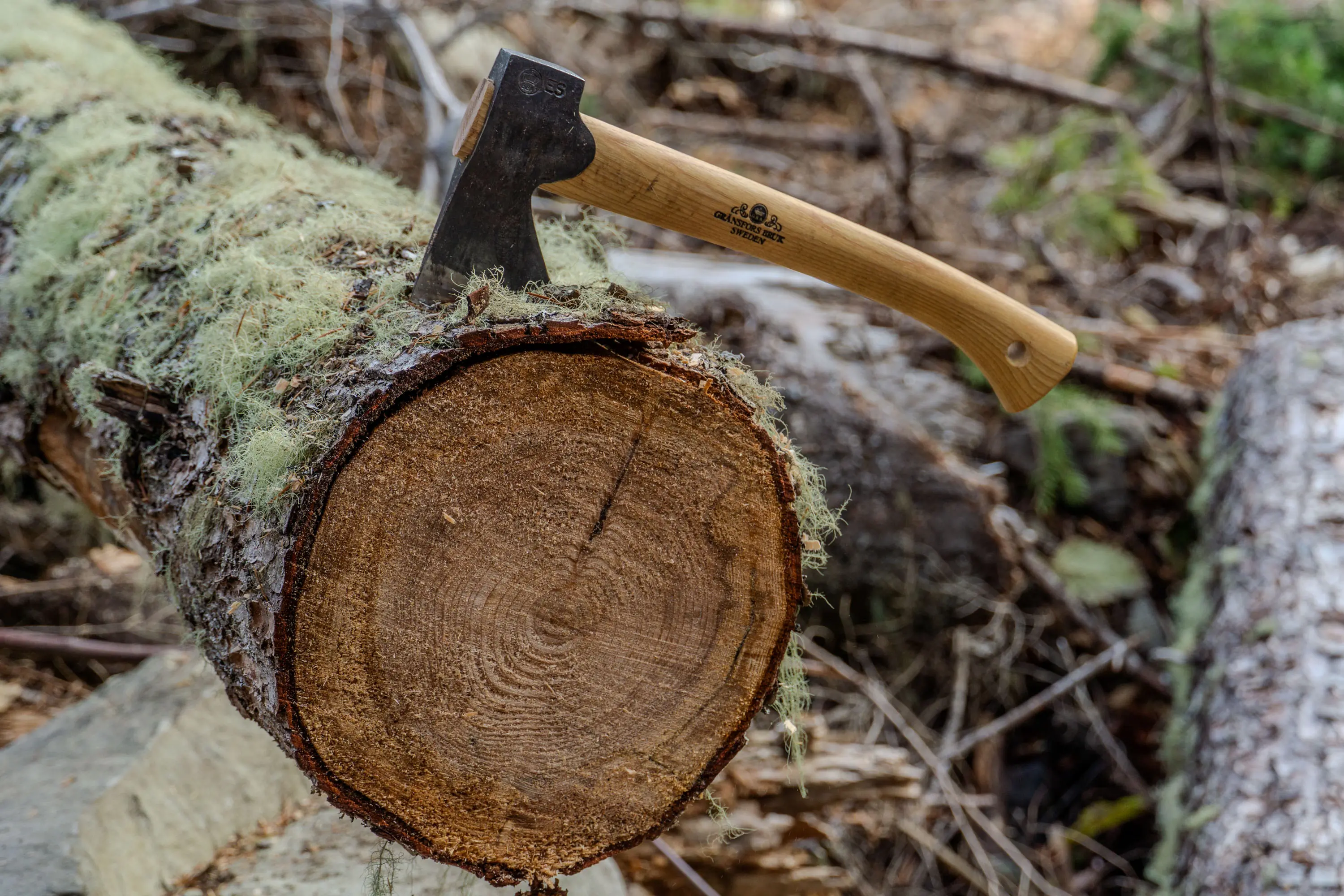



Our approach is to prove or disprove manufacturers’ claims about their products. That covers form and function, as well as the materials being used. So, during field testing, we’re looking at specifics, such as whether certain steel holds up in wet weather conditions or whether synthetic handles absorb shock better than wood handles.
We’re also thinking outside the box to see what else we can do with these hatchets. We want to cover all the bases so that if you have questions, we have answers. This has taken us across the country’s woodlands, from the hardwood groves of the Northeast to the lumbering old-growth of the Pacific Northwest. We put these hatchets into the hands of trail crew leaders, casual campers, and survival experts to get the spread of opinions.
Beyond that, we’re following trends. We’re looking to see what’s new in the market that could be a game-changer; the next big thing. This allows us to keep our info up to date so that you can rely on us to help you choose the right hatchet for your next adventure. We also reviewed the Best Axes for Splitting Wood for those looking for a heavier-duty splitting tool.
It’s important to us that we’re using these tools in real-life situations. Because, after all, that’s where you’ll be using them. It also allows us to consider weather conditions, fatigue, and any other variable that can come up in life that may not be in a controlled environment.
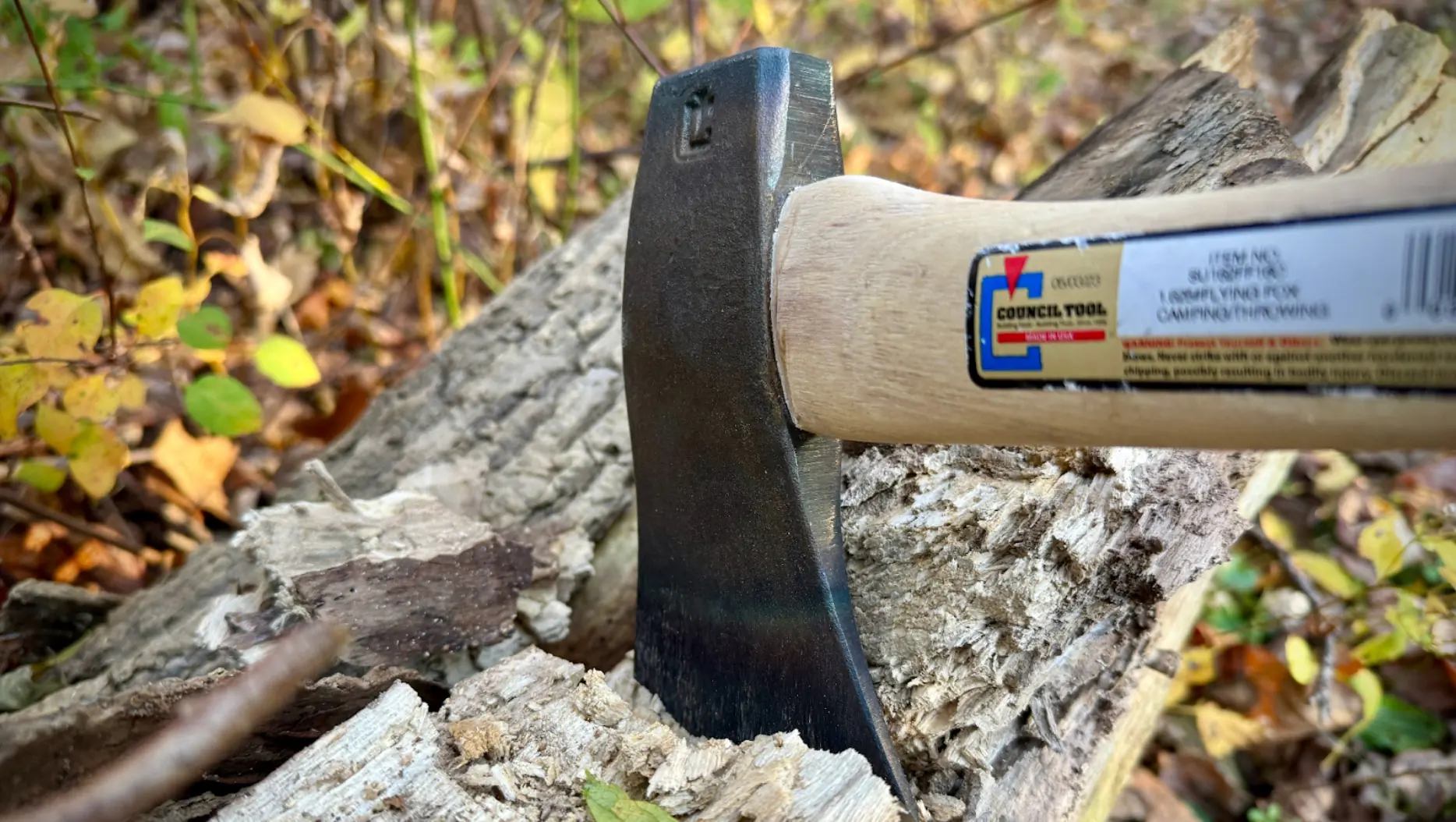



Our Expert Testers
For our most recent update, we tapped contributor Nick LeFort to fill his backpack and head into the woods to see what this year’s batch would be. LeFort spent weeks in the woods of Vermont and Connecticut, as well as in his own backyard, discovering the current cream of the crop in the world of hatchets.
LeFort is an outdoor enthusiast, engineer, and knifemaker who has worked and played in the outdoor industry for more than 20 years. He brings with him a wealth of knowledge about materials, engineering, manufacturing, and marketing, and has nearly 30 years of experience in the outdoor world.
What’s more, he’s been testing and reviewing knives, tools, and gear for more than a decade. He’s dedicated to the cause, has a lot to say, and wants to make sure you’re getting the best information you can from us.




Buyer’s Guide: How to Choose the Best Camping Hatchet
When seeking out the best camping hatchet, there’s a lot to consider. Ultimately, the best hatchet for you may not be the best hatchet for someone else, and it will take weighing some personal pros and cons before you gain full confidence in your decision.
You also should consider whether a hatchet is the best tool for the job. Processing wood outdoors can look pretty different depending on the size and scale of your endeavors, with full-sized axes being primed for tree felling, bushcraft knives working excellently for fine work, and hatchets landing somewhere in the middle.
As you shop around for hatchets, consider the following points of differentiation as you move closer to your final decision. If you’re stuck between a couple of options, there’s no harm in having multiple tools in the toolbox!


Hatchet Head Anatomy
Where there are more than enough shapes and sizes for Axe heads, hatchet heads tend to all be similar; especially when we’re talking about traditional hatchets. When we get into modern hatchets, some — like the Gerber Bushcraft Hatchet and the CRKT Chogan Hatchet — may pick up attributes added in to make splitting wood easier.
But for the most part, a good hatchet head is forged, and not cast. This eliminates impurities that would weaken the steel. Additionally, a hatchet head will be at or under 2 pounds and have a bit that is less than 4”.
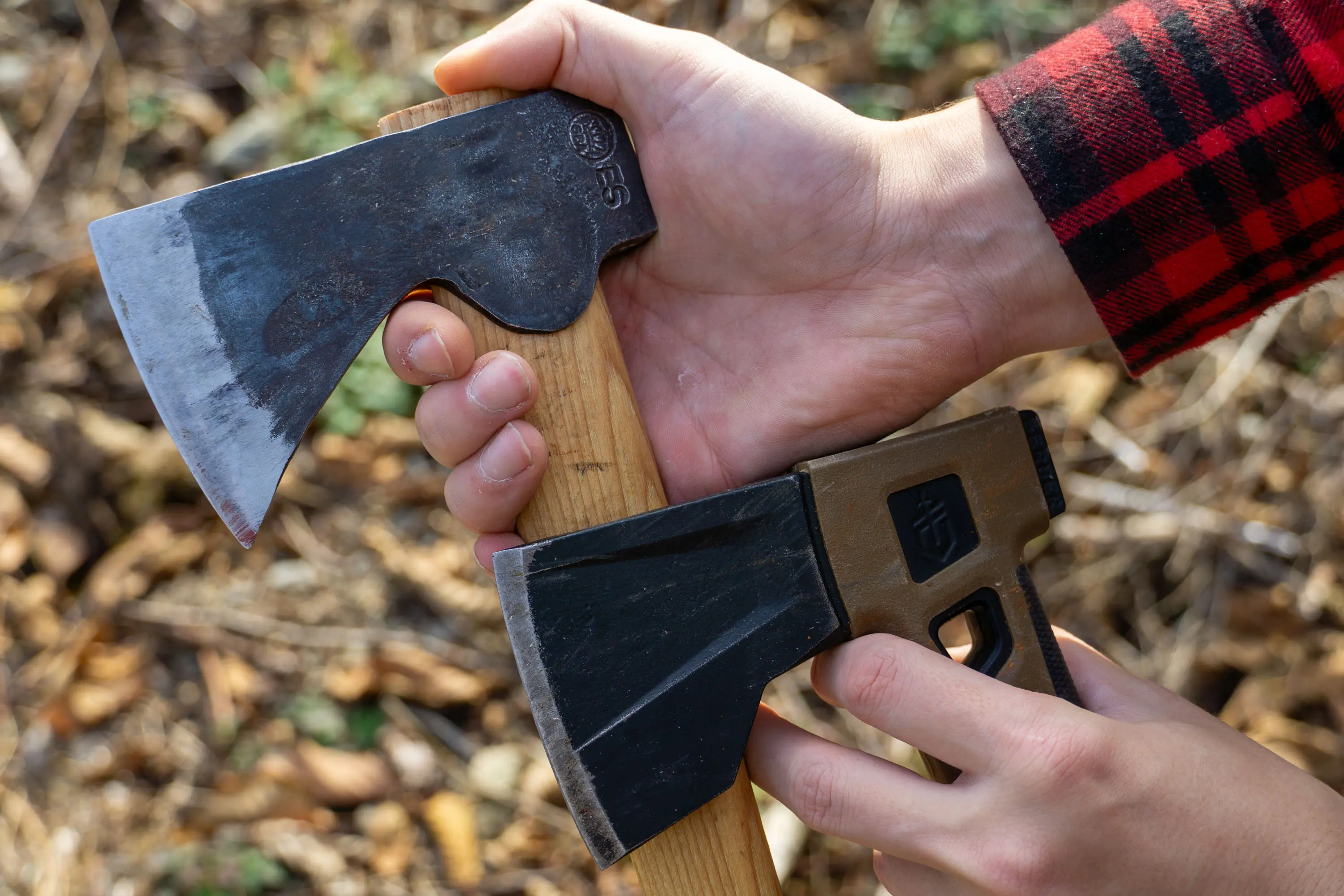



What’s a bit? Well, we’re glad you asked. A “bit” is the blade of the hatchet head. If you want to sound really on your game at a cocktail party, you could refer to your hatchet as a “single bit” as it only has one sharp edge. Here are a few other terms you should get to know:
- Cheek: The cheek of the hatchet head is the side profile of the head. Unless the head has splitting attributes, this will be smooth and sometimes convex.
- Butt: The back of the hatchet, which you can use as a hammer. Unless specified otherwise.
- Beard: The beard of the hatchet head uses the bottom of the head in front of the handle. Depending on the shape, you can use the heel, or bottom of the bit, to roll and drag branches and logs. Additionally, the top of the bit is known as a toe.
- Eye: The eye of the hatchet is where the handle slides through the head. If the butt isn’t hardened, you run the risk of deforming the eye, which will cause the head to fall off.
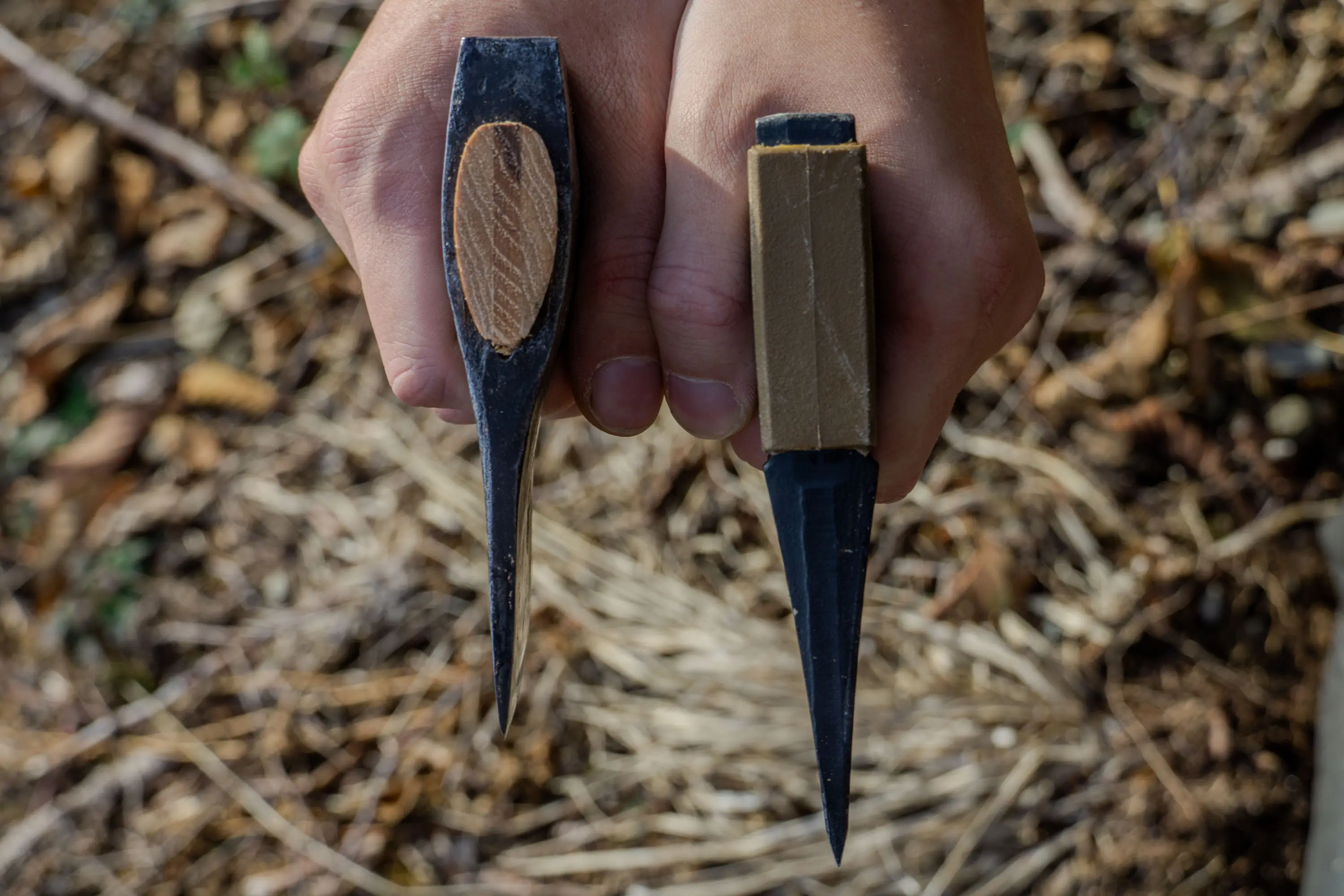



Head Coatings
Another feature associated with most axe and hatchet heads is some form of coating. These coatings are added to stave off corrosion and abrasion and preserve the life of your tool. These coatings come in many different forms.
For traditional hatchets like the Husqvarna Swedish Style Hatchet and the Gränsfors Bruk Wildlife Hatchet, these coatings can be oil-based and are added during forging or a secondary finishing process. They change the actual finish on the surface of the steel and could require recoating after years of use and abuse.
Some modern hatchets, like the Fiskars Norden N7 Hatchet, the TOPS Hammer Hawk, and the Gerber Bushcraft Hatchet, may use modern techniques similar to what we see on knife steel. This could range from a black oxide coating to a diamond-like coating (DLC) to ceramic Cerakoting. They act as a secondary layer bonded to the head steel and are noted to reduce friction and their years of resistance.
There are hatchets out there that do not have any coating and rely on their chemistry to stave off corrosion and abrasion. The Estwing Sportsman’s Axe doesn’t have any coating on its tool-grade steel head and handle. Though it will provide you with years of reliable cutting, you need to remember to keep it clean so that it doesn’t corrode. That said, you’ll note that Estwing does offer a special edition of their Sportsman’s Axe that adds a corrosion-resistant coating to the steel.
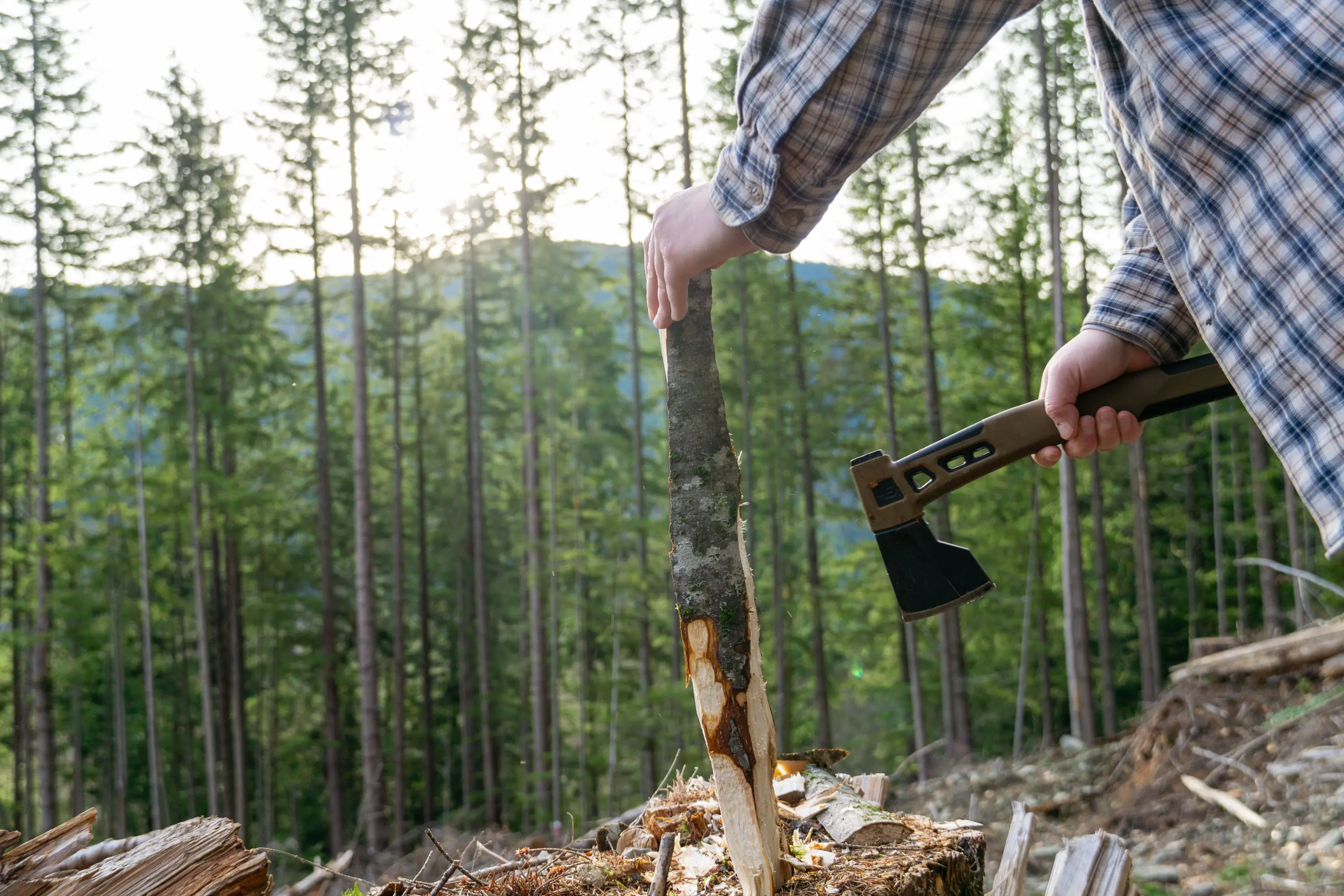



Head Weight and Handle Length
Two of the most important considerations when buying an axe are choosing its head weight and handle length. Both of these decisions can be almost entirely informed by determining the hatchet’s intended use.
The average hatchet handle length ranges from 12 to 18 inches. The average head weight ranges from 1.5 to 2.5 pounds. In order to determine the right combination of head weight and handle length, you want to find balance. To check that, you can lay the hatchet across your palm just below the head. If it balances in place, then the ratio is spot on.
The reason behind all of this is leverage. You want to let the tool do the work so you don’t get fatigued. It’s a tale as old as time and something that comes with using a hatchet over and over again. If it’s well balanced, the weight of the head and the length of the handle should work in synchrony to make chopping things energy efficient.
Where you plan on using your camp hatchet the most often is also worth consideration. If the majority of your camping is done on the roadside, weight shouldn’t matter much.
If you spend a lot of time off-trail or backpacking deep into the wilderness, weight matters. In this case, sacrificing some functionality to save some weight in your backpack may be required.


Ease of Splitting
The ease of splitting is a crucial thing to consider when purchasing a camp hatchet. If you are buying a hatchet with wood shaping and detail work in mind, wood splitting may not be a primary concern. If you envision yourself felling trees and splitting wood often, then the ease of splitting should move to the front of your mind. For heavy-duty splitting projects, check out our Buyer’s Guide of the Best Axes for Splitting Wood.
Again, longer handles and heavier axe heads generally lend themselves to easier splitting as does the head and bit shape. Consider the construction of the head and shape of the handle when shopping between similar models as well.
As you explore options, if you decide you need a tool fully dedicated to wood splitting, take a look at larger axes instead of hatchets. It’s entirely possible that the more compact camp hatchets on this list aren’t what you need after all, and you require a heavy-duty, full-size axe.
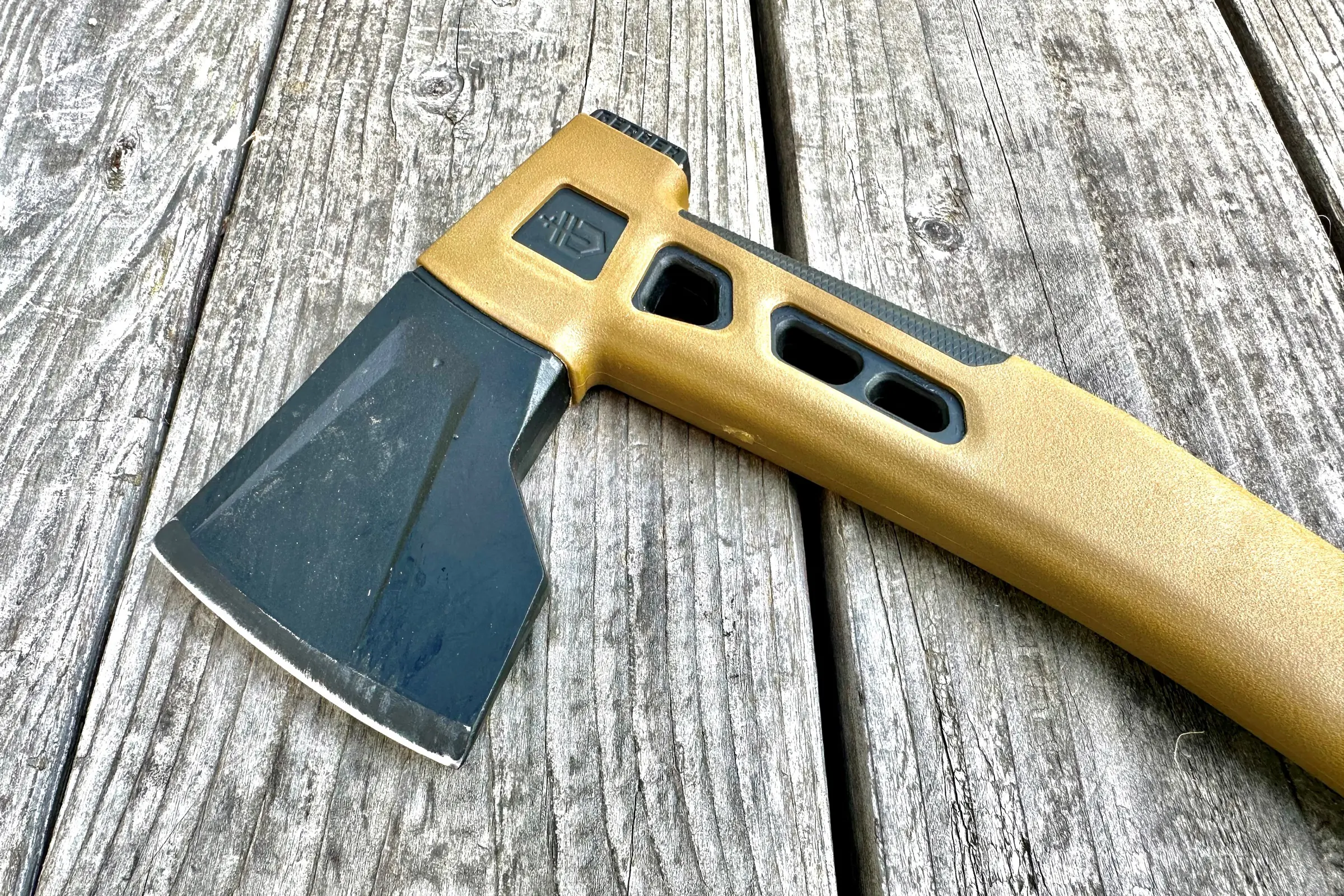



Durability
Both materials and construction play directly into the durability of the best camping hatchets.
When shopping and considering various options, pay special attention to the materials used to create the head and, to a lesser extent, the hatchet handle. The highest-quality hatchets will have forged steel heads, with a stronger preference edging toward those that are hand-forged.
It’s also worth noting how the head is attached to the shaft. Each user will have their preference, from full tang to separate pieces, and each style comes with its pros and cons.
Do diligent research on company websites and track down user reviews. These often provide excellent metrics when gauging the durability of a tool that will surely be put to use.


Carry
If you’re headed out on an adventure, you need to be conscious of how you’re going to carry your hatchet.
Most hatchets come with either a leather or composite sheath that allows you to lash the hatchet to the outside of your pack, or even throw it inside. The sheath also protects the bit from getting banged around and beat up and from cutting into anything it comes into contact with while traveling (including you).
Unless you’re buying a hatchet to leave in one place all the time, like your backyard, prioritize the hatchets with sheaths on your final list of what you’re considering buying.




Maintenance
Like any other tool, preventative maintenance will prolong the life of your hatchet. In most cases, you’ll need to maintain the head more than the handle. But if your hatchet has a wooden handle, it’s going to need some sprucing up from time to time. Here are a few essentials we recommend for keeping your hatchet up and running for the long run.
Head and Handle Coating
Even with most hatchet heads having some sort of treatment to help with corrosion resistance, it’s still a good idea to either wax or lube the head. This will enhance any corrosion protection the manufacturer applied, or help protect an older or untreated head. We recommend the Hardcore Hammer’s Tool Lube ($20). Not only is this all-natural salve good on metal, but it can come in handy in treating wood and leather as well.
Bit Sharpening and Repair
Based on how they’re used, hatchet bits generally get dull fast. They can also get chipped if they hit something left behind in the wood. There’s a lot of old farmland peppered throughout the land, and you never know what tree may have had a bit of barbed wire wrapped around it or a nail hammer to it. Trees are resilient and will grow around anything that invades its fibers over time.
We recommend using a puck-style sharpening stone to fix a chip in a blade or sharpen your bit. Lansky Sharpeners offers its Puck Dual Grit Sharpener ($11), which has a 120-grit side for repairs and a 280-grit side for honing and sharpening. Similarly, Hardcore Hammers offers its Sharpening Stone with Leather Pouch ($60). It has a 100-grit side for repairs and a 220-grit side for honing and sharpening.
Tester Nick LeFort has been using the Lansky Puck for the last 20 years. As part of the testing process, he began using the Hardcore Hammers Sharpening Stone. Both are quality products that will restore or resharpen any axe or hatchet head. The advantage of the Hardcore Hammers Sharpening Stone is the leather pouch. Both stones perform the same, even with the differences in grits.
Price & Value
As with any outdoor gear, price plays a role in deciding between similar products. Most hatchets, and especially those on our list above, are fairly priced. But that doesn’t always mean the price determines what the best hatchet is. However, there are determining factors in the final price you will pay.
Consider what you’re getting for the price you’re paying: How many tools can it function as? What are the materials being used? Does it come with a sheath? Good camping hatchets can range from garden-section implements for limbing trees all the way to investment pieces from boutique manufacturers who use the finest materials and techniques.
Budget
If you’ve just got some kindling to split, a solid budget hatchet will get the job done. Expect to pay around $35-50 for a basic chopper like this, which will likely use a drop-forged steel head and commonly a composite handle (though some shellacked wood does exist). The Fiskars X7 ($35) is an excellent example, and it performed well in our chopping tests.
The lesser-quality tool steel used in the Estwing Sportsman’s Axe ($55) helps to explain the price there, and while the Husqvarna Swedish Style Hatchet ($70) is a bit beyond the budget tier, it is just about the most affordable you’ll find hand-forged Swedish steel and a hardwood handle, making it a killer value.
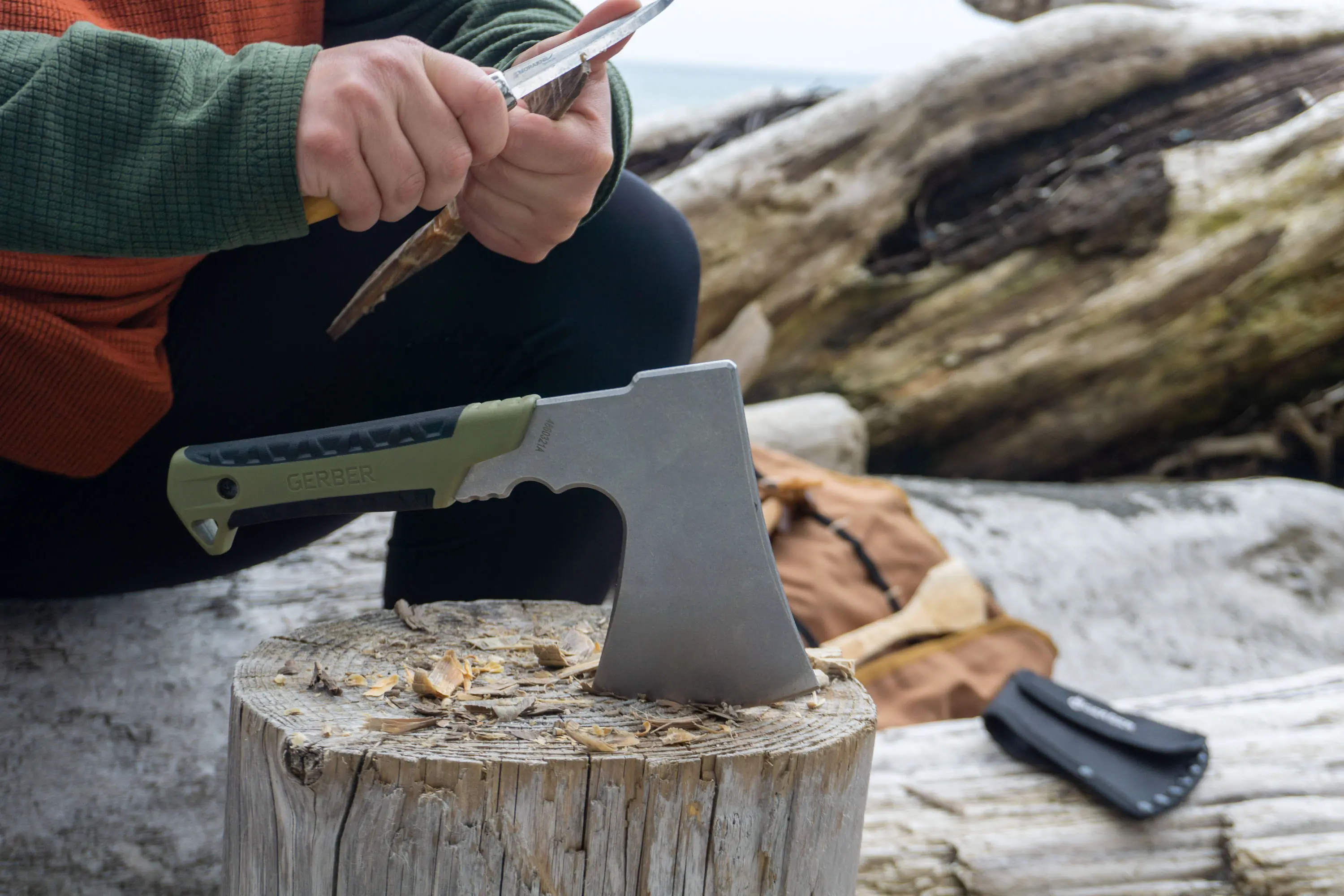



Mid-Tier
Paying $100-200 for a hatchet opens up quite a few more options, along with the frequent designation of “hand-crafted”. Nordic brands like Gränsfors Bruk and Hults Bruk make excellent hatchets for the money, and you’re buying into some serious history (some forges have been running since the 17th century). You’ll get mostly hand-forged steel heads here, along with hardwood handles and fine leather sheaths.
The Fiskars Norden N7 ($120) gives up a little in the steel department, but makes up for it with the composite overstrike protection built into the handles. If you’re after a more traditional example, the Gränsfors Bruk Wildlife Hatchet ($185) is a through-and-through classic, and the same can be said of the Hults Bruk Almike ($199).
Premium
Paying more than $200 for a hatchet means that you’re buying into a fine example of craftsmanship, with boutique brands that spend a lot of R&D on getting a design just right. The steels used here are high-performance, like CPM S90V or 1075, can be coated with Cerakote to provide added durability, and are mated to handles of fine hardwoods or pricey composite laminated grips.
The TOPS Hammer Hawk ($530) is a top-dollar unit but is a USA-made tool that is solid steel and swings like every bit of that price.
Frequently Asked Questions
Choosing the best camping hatchet is almost entirely dependent on the individual and its intended use. Some companies certainly have a stronger reputation than others, but choosing the single best camping hatchet for everyone is a nearly impossible task.
We did our best in outlining some of our favorites above and ultimately chose the Hardcore Hammers Camp Companion Axe (traditional) and Gerber Bushcraft Hatchet (modern) as our overall favorites. That said, that doesn’t mean these two hatchets are for everyone.
Sort your priorities and intended uses, and weigh some pros and cons of various options. You will soon find that the best camping hatchet for you may not be the best hatchet for your camping partner.




While you certainly do not need a hatchet for camping, it does make our list as a top tool to have on any camping adventure. Hatchets are multifaceted tools; from instruments of survival to campground maintenance tools, hatchets can be used for many things in the woods.
We can say with almost full confidence that you will never regret having a hatchet with you when camping. Inevitably, someone will pick it up to split wood, make kindling, or tinker with a small bushcraft project around the fire. There is also something to be said about learning new skills and promoting self-sufficiency when out in the woods.
What’s more fun — having firewood delivered or using newly learned skills to gather your own?
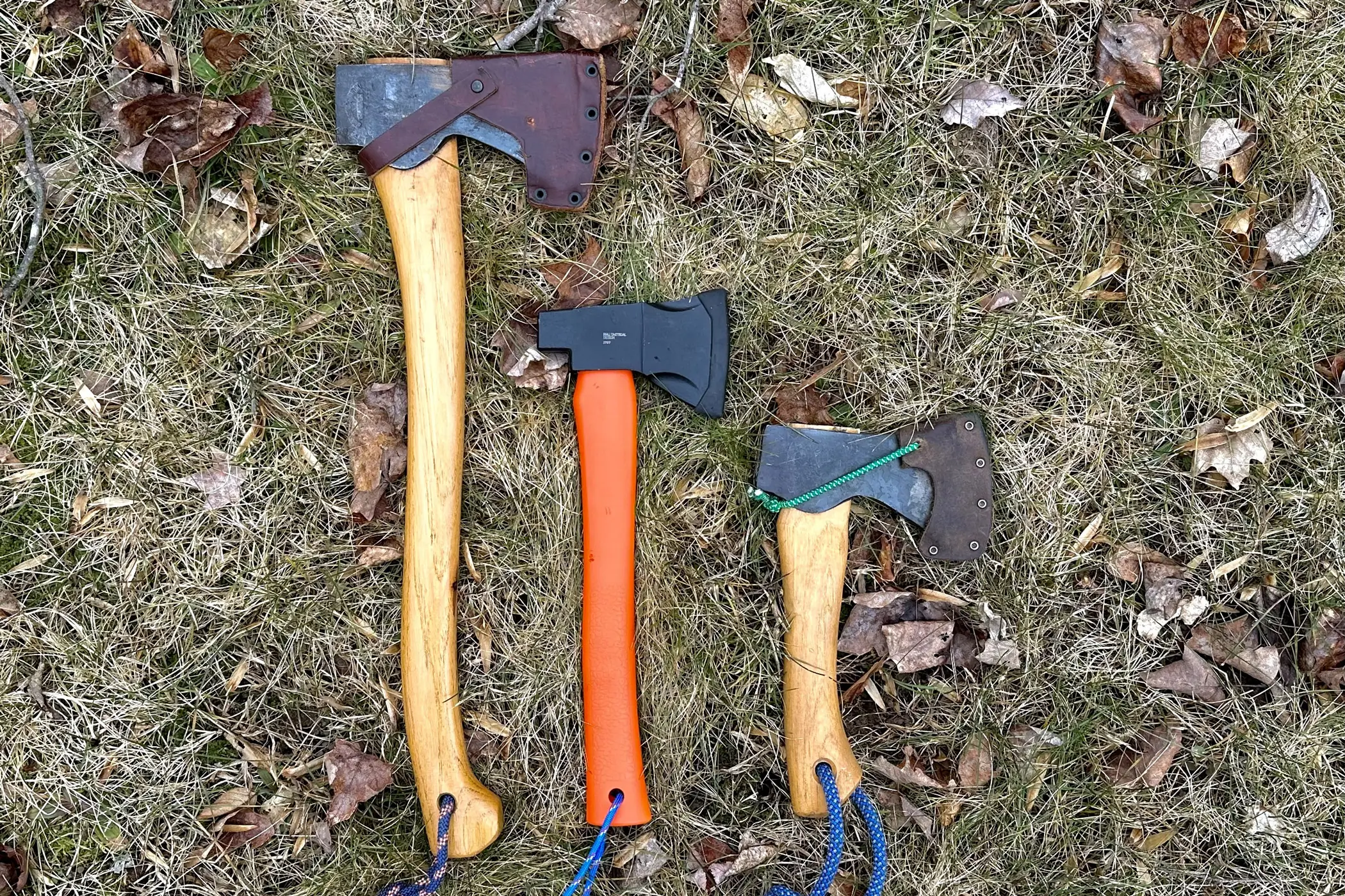



All hatchets are axes, but not all axes are hatchets.
In short, hatchets are just small, lightweight axes. Axes can and often should be used with one hand as an all-purpose tool.
The classic grip to use a standard axe requires two hands. These axes are less utilitarian and have a more focused design for tree felling, wood chopping, and other forestry needs.
Depending on shape and construction, hatchets are good for quite a lot. Their most common purpose is for chopping and splitting smaller sections of wood. Hatchets excel at cutting green wood or chopping dead wood roughly the diameter of an average forearm and slightly bigger.
Given their smaller size, hatchets are excellent tools for more intricate bushcraft tasks. They are the perfect instrument for shelter design or carving and crafting woodworking projects. In a bind, hatchets work when cutting through bone and cartilage if you do not have a field dressing knife on you following a hunt.
For a deeper, expanded look at the possibilities a hatchet can provide, check out this article.


A good hatchet will last for generations, but it will require some upkeep. Most of the hatchets on our list are sharp straight out of the box, but some may come from the factory without an edge. Either way, every hatchet will eventually need maintenance to keep it in good, safe, working order.
The frequency with which you sharpen your hatchet will depend on how often you use it and what you are using it for. If you purchased a high-quality hatchet, only go camping once or twice a year, and use it sparingly, you may not need to sharpen it frequently.
Many hatchets come with user manuals for guidance in sharpening, or you might consult the U.S. Forest Service Ax Manual. Some hatchets even include a file and sharpening stone with your purchase. We’ve relied on this Dual Grit Sharpener for years as it’s easy to use, can restore an edge quickly, and doesn’t take up much space in your pack.
Many professionals sharpen knives and axes for a living. If you don’t have the time to give your hatchet the proper maintenance it deserves, consider taking it to someone who does.
Different manufacturers may have specific recommendations on how to store your hatchet when you’re not using it. You can always refer to the included manual or their website for specific instructions.
Beyond that, we recommend you clean up your hatchet before storing it. Any moisture and debris can impact the overall quality and reliability of your hatchet over time. Make sure to clean off the head of any debris and wipe it dry before putting it back in the sheath.
As wood handles start to age, over time they may require a rewaxing or sealing. There are a few different methods for doing this, but we recommend following the manufacturer’s instructions and using any products they offer to restore the handle to its original state.
With any piece of gear or clothing, it’s best to store it in a dry place. Hatchets are a little hardier than some of the other gear you take along with you on your adventures, but that doesn’t mean that they’re not susceptible to the elements.
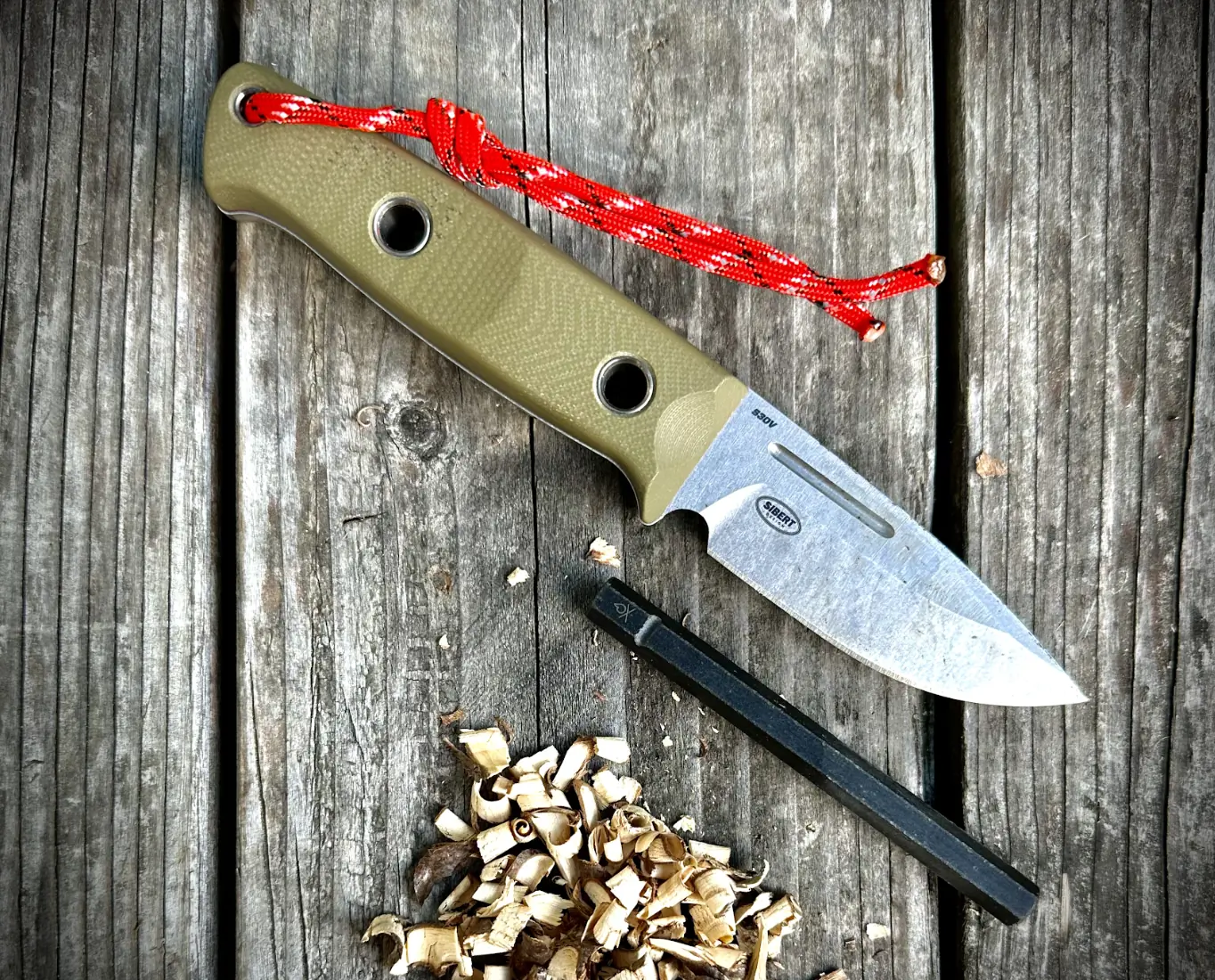

The Best Bushcraft Knives of 2025
Whether splitting logs or whittling by the fire, we’ve found the best bushcraft knives for every budget and use.


The Best Tactical Knives of 2025
Known by many names, a tactical knife generally refers to a hardworking, do-all blade. Here, we review the best folding and fixed-blade knives for every budget and use.
